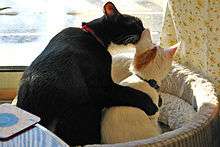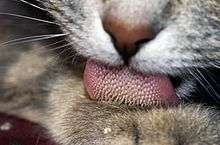Cat
| Domestic cat[1] | |
|---|---|
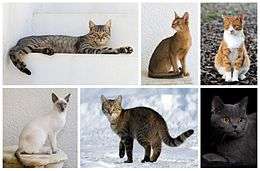 | |
| Various types of domestic cat | |
Domesticated | |
| Scientific classification | |
| Kingdom: | Animalia |
| Phylum: | Chordata |
| Class: | Mammalia |
| Order: | Carnivora |
| Suborder: | Feliformia |
| Family: | Felidae |
| Subfamily: | Felinae |
| Genus: | Felis |
| Species: | F. silvestris |
| Subspecies: | F. s. catus |
| Trinomial name | |
| Felis silvestris catus | |
| Synonyms | |
|
Felis catus Linnaeus, 1758 | |
The cat (Felis catus, or Felis silvestris catus, literally "woodland cat")[4][1][5], often referred to as the domestic cat to distinguish from other felids and felines, is a small, typically furry, carnivorous mammal. It is often called house cat[6] when kept as indoor pet or feral/feral domestic cat when wild.[7] It is often valued by humans for companionship and for its ability to hunt vermin. There are more than seventy cat breeds recognized by various cat registries.
Cats are similar in anatomy to the other felids, with a strong flexible body, quick reflexes, sharp teeth and retractable claws adapted to killing small prey. Cat senses fit a crepuscular and predatory ecological niche. Cats can hear sounds too faint or too high in frequency for human ears, such as those made by mice and other small animals. They can see in near darkness. Like most other mammals, cats have poorer color vision and a better sense of smell than humans. Cats, despite being solitary hunters, are a social species, and cat communication includes the use of a variety of vocalizations (mewing, purring, trilling, hissing, growling and grunting) as well as cat pheromones and types of cat-specific body language.[8]
Cats have a high breeding rate.[9] Under controlled breeding, they can be bred and shown as registered pedigree pets, a hobby known as cat fancy. Failure to control the breeding of pet cats by spaying and neutering, as well as the abandonment of former household pets, has resulted in large numbers of feral cats worldwide, requiring population control.[10] In certain areas outside cats' native range, this has contributed, along with habitat destruction and other factors, to the extinction of many bird species. Cats have been known to extirpate a bird species within specific regions and may have contributed to the extinction of isolated island populations.[11] Cats are thought to be primarily responsible for the extinction of 87 species of birds,[12] and the presence of feral and free-ranging cats makes some otherwise suitable locations unsuitable for attempted species reintroduction.[13]
Because cats were venerated in ancient Egypt, they were commonly believed to have been domesticated there,[14] but there may have been instances of domestication as early as the Neolithic from around 9,500 years ago (7500 BC).[15] Results of a genetic study in 2007 showed that all domestic cats descended from the Near Eastern wildcat and diverged around 8000 BC in the Middle East.[16][14][17] The leopard cat was domesticated independently in China around 5500 BC, though this line of partially domesticated cats leaves no trace in the domesticated populations of today.[18][19] A 2017 study confirmed that domestic cats are descendants of those first domesticated by farmers in the Near East around 9,000 years ago.[20][21]
As of a 2007 study, cats are the second-most popular pet in the U.S. by number of pets owned, after freshwater fish.[22] In a 2010 study, they were ranked the third-most popular pet in the UK, after fish and dogs, with around 8 million being owned.[23]
Taxonomy and evolution
The domestic cat is a member of the cat family, the felids, which are a rapidly evolving family of mammals that share a common ancestor only 10–15 million years ago[24] and include lions, tigers, cougars and many others. Within this family, domestic cats (Felis catus) are part of the genus Felis, which is a group of small cats containing about seven species (depending upon classification scheme).[1][25] Members of the genus are found worldwide and include the jungle cat (Felis chaus) of southeast Asia, European wildcat (F. silvestris silvestris), African wildcat (F. s. lybica), the Chinese mountain cat (F. bieti), and the Arabian sand cat (F. margarita), among others.[26]
The domestic cat is believed to have evolved from the Near Eastern wildcat, whose range covers vast portions of the Middle East westward to the Atlantic coast of Africa.[27][28] Between 70,000 and 100,000 years ago the animal gave rise to the genetic lineage that eventually produced all domesticated cats,[29] having diverged from the Near Eastern wildcat around 8,000 BC in the Middle East.[14][17]
The domestic cat was first classified as Felis catus by Carl Linnaeus in the 10th edition of his Systema Naturae published in 1758.[1][2] Because of modern phylogenetics, domestic cats are usually regarded as another subspecies of the wildcat, F. silvestris.[1][30][31] This has resulted in mixed usage of the terms, as the domestic cat can be called by its subspecies name, Felis silvestris catus.[1][30][31] Wildcats have also been referred to as various subspecies of F. catus,[31] but in 2003, the International Commission on Zoological Nomenclature fixed the name for wildcats as F. silvestris.[32] The most common name in use for the domestic cat remains F. catus. Sometimes, the domestic cat has been called Felis domesticus[33] as proposed by German naturalist J. C. P. Erxleben in 1777,[34] but these are not valid taxonomic names and have been used only rarely in scientific literature.[35] A population of Transcaucasian black feral cats was once classified as Felis daemon (Satunin 1904) but now this population is considered to be a part of the domestic cat.[36]
All the cats in this genus share a common ancestor that is believed to have lived around 6–7 million years ago in the Near East (the Middle East).[37] The exact relationships within the Felidae are close but still uncertain,[38][39] e.g. the Chinese mountain cat is sometimes classified (under the name Felis silvestris bieti) as a subspecies of the wildcat, like the North African variety F. s. lybica.[30][38]
In comparison to dogs, cats have not undergone major changes during the domestication process, as the form and behavior of the domestic cat is not radically different from those of wildcats and domestic cats are perfectly capable of surviving in the wild.[40][41] Fully domesticated house cats often interbreed with feral F. catus populations,[42] producing hybrids such as the Kellas cat. This limited evolution during domestication means that hybridisation can occur with many other felids, notably the Asian leopard cat.[43] Several natural behaviors and characteristics of wildcats may have predisposed them for domestication as pets.[41] These traits include their small size, social nature, obvious body language, love of play and relatively high intelligence.[44]:12–17 Several small felid species may have an inborn tendency towards tameness.[41]
Cats have either a mutualistic or commensal relationship with humans. Two main theories are given about how cats were domesticated. In one, people deliberately tamed cats in a process of artificial selection as they were useful predators of vermin.[45] This has been criticized as implausible, because the reward for such an effort may have been too little; cats generally do not carry out commands and although they do eat rodents, other species such as ferrets or terriers may be better at controlling these pests.[30] The alternative idea is that cats were simply tolerated by people and gradually diverged from their wild relatives through natural selection, as they adapted to hunting the vermin found around humans in towns and villages.[30]
Nomenclature and etymology
The origin of the English word cat (Old English catt) and its counterparts in other Germanic languages (such as German Katze), descended from Proto-Germanic *kattōn-, is controversial. It has traditionally thought to be a borrowing from Late Latin cattus, 'domestic cat', from catta (used around 75 AD by Martial),[46][47] compare also Byzantine Greek κάττα, Portuguese and Spanish gato, French chat, Maltese qattus, Lithuanian katė, and Old Church Slavonic kotъ (kot'), among others.[48] The Late Latin word is generally thought to originate from an Afro-Asiatic language, but every proposed source word has presented problems. Many references refer to "Berber" (Kabyle) kaddîska, 'wildcat', and Nubian kadīs as possible sources or cognates, but M. Lionel Bender suggesets the Nubian term is a loan from Arabic قِطَّة qiṭṭa.[49] Jean-Paul Savignac suggests the Latin word is from an Ancient Egyptian precursor of Coptic ϣⲁⲩ šau, 'tomcat', or its feminine form suffixed with -t,[50] but John Huehnergard says "the source [...] was clearly not Egyptian itself, where no analogous form is attested."[49] Huehnergard opines it is "equally likely that the forms might derive from an ancient Germanic word, imported into Latin and thence to Greek and to Syriac and Arabic". Guus Kroonen also considers the word to be native to Germanic (due to morphological alternations) and Northern Europe, and suggests that it might ultimately be borrowed from Uralic, cf. Northern Sami gáđfi, 'female stoat', and Hungarian hölgy, 'stoat'; from Proto-Uralic *käďwä, 'female (of a furred animal)'.[51] In any case, cat is a classic example of a Wanderwort.
An alternative word is English puss (extended as pussy and pussycat). Attested only from the 16th century, it may have been introduced from Dutch poes or from Low German puuskatte, related to Swedish kattepus, or Norwegian pus, pusekatt. Similar forms exist in Lithuanian puižė and Irish puisín or puiscín. The etymology of this word is unknown, but it may have simply arisen from a sound used to attract a cat.[52][53]
A group of cats can be referred to as a clowder or a glaring;[54] a male cat is called a tom or tomcat[55] (or a gib,[56] if neutered); an unspayed female is called a queen,[57] especially in a cat-breeding context; and a juvenile cat is referred to as a kitten. The male progenitor of a cat, especially a pedigreed cat, is its sire,[58] and its mother is its dam.[59] In Early Modern English, the word kitten was interchangeable with the now obsolete word catling.[60]
A pedigreed cat is one whose ancestry is recorded by a cat fancier organization. A purebred (or pure-bred) cat is one whose ancestry contains only individuals of the same breed. Many pedigreed and especially purebred cats are exhibited as show cats. Cats of unrecorded, mixed ancestry are referred to as domestic short-haired or domestic long-haired cats (by coat type), or commonly as random-bred, moggies (chiefly British), or (using terms borrowed from dog breeding) mongrels or mutt-cats.
While the African wildcat is the ancestral subspecies from which domestic cats are descended, and wildcats and domestic cats can completely interbreed (being subspecies of the same species), several intermediate stages occur between domestic pet and pedigree cats on one hand and entirely wild animals on the other. The semi-feral cat, a mostly outdoor cat, is not owned by any one individual, but is generally friendly to people and may be fed by several households. Truly feral cats are associated with human habitation areas, foraging for food and sometimes intermittently fed by people, but are typically wary of human interaction.[42]
Biology
Anatomy

Domestic cats are similar in size to the other members of the genus Felis, typically weighing between 4 and 5 kg (9 and 10 lb).[38] Some breeds, such as the Maine Coon, can occasionally exceed 11 kg (24 lb). Conversely, very small cats, less than 2 kg (4 lb), have been reported.[61] The world record for the largest cat is 21 kg (50 lb).[62] The smallest adult cat ever officially recorded weighed around 1 kg (2 lb).[62] Feral cats tend to be lighter, as they have more limited access to food than house cats. The Boston Cat Hospital weighed trapped feral cats, and found the average feral adult male to weigh 4 kg (9 lb), and average adult female 3 kg (7 lb).[63] Cats average about 23–25 cm (9–10 in) in height and 46 cm (18 in) in head/body length (males being larger than females), with tails averaging 30 cm (12 in) in length;[64] feral cats may be smaller on average.
Cats have seven cervical vertebrae, as do almost all mammals; 13 thoracic vertebrae (humans have 12); seven lumbar vertebrae (humans have five); three sacral vertebrae like most mammals (humans have five); and a variable number of caudal vertebrae in the tail (humans have only vestigial caudal vertebrae, fused into an internal coccyx).[65]:11 The extra lumbar and thoracic vertebrae account for the cat's spinal mobility and flexibility. Attached to the spine are 13 ribs, the shoulder, and the pelvis.[65] :16 Unlike human arms, cat forelimbs are attached to the shoulder by free-floating clavicle bones which allow them to pass their body through any space into which they can fit their head.[66]
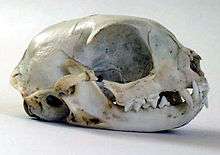
The cat skull is unusual among mammals in having very large eye sockets and a powerful specialized jaw.[67]:35 Within the jaw, cats have teeth adapted for killing prey and tearing meat. When it overpowers its prey, a cat delivers a lethal neck bite with its two long canine teeth, inserting them between two of the prey's vertebrae and severing its spinal cord, causing irreversible paralysis and death.[68] Compared to other felines, domestic cats have narrowly spaced canine teeth, which is an adaptation to their preferred prey of small rodents, which have small vertebrae.[68] The premolar and first molar together compose the carnassial pair on each side of the mouth, which efficiently shears meat into small pieces, like a pair of scissors. These are vital in feeding, since cats' small molars cannot chew food effectively, and cats are largely incapable of mastication.[67]:37 Although cats tend to have better teeth than most humans, with decay generally less likely because of a thicker protective layer of enamel, a less damaging saliva, less retention of food particles between teeth, and a diet mostly devoid of sugar, they are nonetheless subject to occasional tooth loss and infection.[69]
Cats, like dogs, are digitigrades. They walk directly on their toes, with the bones of their feet making up the lower part of the visible leg.[70] Cats are capable of walking very precisely because, like all felines, they directly register; that is, they place each hind paw (almost) directly in the print of the corresponding fore paw, minimizing noise and visible tracks. This also provides sure footing for their hind paws when they navigate rough terrain. Unlike most mammals, when cats walk, they use a "pacing" gait; that is, they move the two legs on one side of the body before the legs on the other side. This trait is shared with camels and giraffes. As a walk speeds up into a trot, a cat's gait changes to be a "diagonal" gait, similar to that of most other mammals (and many other land animals, such as lizards): the diagonally opposite hind and fore legs move simultaneously.[71]
Like almost all members of the Felidae, cats have protractable and retractable claws.[72] In their normal, relaxed position, the claws are sheathed with the skin and fur around the paw's toe pads. This keeps the claws sharp by preventing wear from contact with the ground and allows the silent stalking of prey. The claws on the fore feet are typically sharper than those on the hind feet.[73] Cats can voluntarily extend their claws on one or more paws. They may extend their claws in hunting or self-defense, climbing, kneading, or for extra traction on soft surfaces. Most cats have five claws on their front paws, and four on their rear paws.[74] The fifth front claw (the dewclaw) is proximal to the other claws. More proximally is a protrusion which appears to be a sixth "finger". This special feature of the front paws, on the inside of the wrists, is the carpal pad, also found on the paws of big cats and dogs. It has no function in normal walking, but is thought to be an antiskidding device used while jumping. Some breeds of cats are prone to polydactyly (extra toes and claws).[74] These are particularly common along the northeast coast of North America.[75]
Physiology
Cats are familiar and easily kept animals, and their physiology has been particularly well studied; it generally resembles those of other carnivorous mammals, but displays several unusual features probably attributable to cats' descent from desert-dwelling species.[33] For instance, cats are able to tolerate quite high temperatures: Humans generally start to feel uncomfortable when their skin temperature passes about 38 °C (100 °F), but cats show no discomfort until their skin reaches around 52 °C (126 °F),[67]:46 and can tolerate temperatures of up to 56 °C (133 °F) if they have access to water.[76]
| Body temperature | 38.6 °C (101.5 °F) |
| Heart rate | 120–140 beats per minute |
| Breathing rate | 16–40 breaths per minute |

Cats conserve heat by reducing the flow of blood to their skin and lose heat by evaporation through their mouths. Cats have minimal ability to sweat, with glands located primarily in their paw pads,[78] and pant for heat relief only at very high temperatures[79] (but may also pant when stressed). A cat's body temperature does not vary throughout the day; this is part of cats' general lack of circadian rhythms and may reflect their tendency to be active both during the day and at night.[80]:1 Cats' feces are comparatively dry and their urine is highly concentrated, both of which are adaptations to allow cats to retain as much water as possible.[33] Their kidneys are so efficient, they can survive on a diet consisting only of meat, with no additional water,[81] and can even rehydrate by drinking seawater.[82][80]:29 While domestic cats are able to swim, they are generally reluctant to enter water as it quickly leads to exhaustion.[83]
Nutrition
Cats are obligate carnivores: their physiology has evolved to efficiently process meat, and they have difficulty digesting plant matter.[33] In contrast to omnivores such as rats, which only require about 4% protein in their diet, about 20% of a cat's diet must be protein.[33] A cat's gastrointestinal tract is adapted to meat eating, being much shorter than that of omnivores and having low levels of several of the digestive enzymes needed to digest carbohydrates.[84] These traits severely limit the cat's ability to digest and use plant-derived nutrients, as well as certain fatty acids.[84] Despite the cat's meat-oriented physiology, several vegetarian or vegan cat foods have been marketed that are supplemented with chemically synthesized taurine and other nutrients, in attempts to produce a complete diet. However, some of these products still fail to provide all the nutrients cats require,[85] and diets containing no animal products pose the risk of causing severe nutritional deficiencies.[86]
Cats do eat grass occasionally. A proposed explanation is that cats use grass as a source of folic acid. Another is that it is used to supply dietary fiber, helping the cat defecate more easily and expel parasites and other harmful material through feces and vomit.[87]
Cats are unusually dependent on a constant supply of the amino acid arginine, and a diet lacking arginine causes marked weight loss and can be rapidly fatal.[88] Arginine is an essential additive in cat food because cats have low levels of the enzymes aminotransferase and pyrroline-5-carboxylate which are responsible for the synthesis of ornithine and citrulline in the small intestine.[89] Citrulline would typically go on to the kidneys to make arginine, but because cats have a deficiency in the enzymes that make it, citrulline is not produced in adequate quantities to make arginine. Arginine is essential in the urea cycle in order to convert the toxic component ammonia into urea that can then be excreted in the urine. Because of its essential role, deficiency in arginine results in a buildup of toxic ammonia and leads to hyperammonemia.[89] The symptoms of hyperammonemia include lethargy, vomiting, ataxia, hyperesthesia and can be serious enough to induce death and coma in a matter of days if a cat is being fed an arginine-free diet. The quick onset of these symptoms is due to the fact that diets devoid in arginine will typically still contain all of the other amino acids, which will continue to be catabolized by the body, producing mass amounts of ammonia that very quickly build up with no way of being excreted.
Another unusual feature is that the cat cannot produce taurine,[note 1] with a deficiency in this nutrient causing macular degeneration, wherein the cat's retina slowly breaks down, causing irreversible blindness.[33] This is due to the hepatic activity of cystinesulfinic acid decarboxylase being low in cats.[91] This limits the ability of cats to biosynthesize the taurine they need from its precursor, the amino acid cysteine, which ultimately results in inadequate taurine production needed for normal function.[91] Deficiencies in taurine result in compensated function of feline cardiovascular and reproductive systems.[91] These abnormalities can also be accompanied by developmental issues in the central nervous system along with degeneration of the retina.[91]
Niacin is an essential vitamin for the cat; dietary deficiency can lead to anorexia, weight loss and an increase in body temperature.[92] Biosynthesis of niacin occurs by metabolism of tryptophan via the kynurenine pathway to quinolinic acid, the niacin precursor. However, cats have a high activity of picolinic acid carboxylase, which converts one of the intermediates to picolinic acid instead of quinolinic acid.[93] As as result niacin can become deficient and require supplementation.[94]
Preformed vitamin A is required in the cat for retinal and reproductive health. Vitamin A is considered to be a fat-soluble vitamin and is seen as essential in a cat's diet. Normally, the conversion of beta-carotenes into vitamin A occurs in the intestine (more specifically the mucosal layer) of species, however cats lack the ability to undergo this process.[94] Both the kidney and liver are contributors to the use of vitamin A in the body of the majority of species while the cats liver does not produce the enzyme Beta-carotene 15,15'-monooxygenase which converts the beta-carotene into retinol (vitamin A).[95] To summarize: cats do not have high levels of this enzyme leading to the cleavage and oxidation of carotenoids not taking place.[93]
Vitamin D3 is a dietary requirement for cats as they lack the ability to synthesize vitamin D3 from sunlight.[96] Cats obtain high levels of the enzyme 7-dehydrocholestrol delta 7 reductase which causes immediate conversion of vitamin D3 from sunlight to 7-dehydrocholesterol.[97] This fat soluble vitamin is required in cats for bone formation through the promotion of calcium retention, along with nerve and muscle control through absorption of calcium and phosphorus.[97]
Cats, like all mammals, need to get linoleic acid, an essential fatty acid, from their diet. Most mammals can convert linoleic acid to arachidonic acid, as well as the omega 3 fatty acids (eicosapentaenoic acid and docosahexaenoic acid) through the activity of enzymes, but this process is very limited in cats.[94] The Δ6-desaturase enzyme eventually converts linoleic acid, which is in its salt form linoleate, to arachidonate (salt form of arachidonic acid) in the liver, but this enzyme has very little activity in cats.[94] This means that arachidonic acid is an essential fatty acid for cats as they lack the ability to create required amounts of linoleic acid. Deficiency of arachidonic acid in cats is related to problems in growth, can cause injury and inflammation to skin (e.g. around the mouth) decreased platelet aggregation, fatty liver, increase in birth defects of kittens whose queens were deficient during pregnancy, and reproductive failure in queens.[94] Arachidonic acid can also be metabolized to eicosanoids that create inflammatory responses which are needed to stimulate proper growth and repair mechanisms in the cat.[98]
Senses
Cats have excellent night vision and can see at only one-sixth the light level required for human vision.[67]:43 This is partly the result of cat eyes having a tapetum lucidum, which reflects any light that passes through the retina back into the eye, thereby increasing the eye's sensitivity to dim light.[99] Another adaptation to dim light is the large pupils of cats' eyes. Unlike some big cats, such as tigers, domestic cats have slit pupils.[100] These slit pupils can focus bright light without chromatic aberration, and are needed since the domestic cat's pupils are much larger, relative to their eyes, than the pupils of the big cats.[100] At low light levels, a cat's pupils will expand to cover most of the exposed surface of its eyes.[101] However, domestic cats have rather poor color vision and (like most nonprimate mammals) have only two types of cones, optimized for sensitivity to blue and yellowish green; they have limited ability to distinguish between red and green.[102] A 1993 paper reported a response to middle wavelengths from a system other than the rods which might be due to a third type of cone. However, this appears to be an adaptation to low light levels rather than representing true trichromatic vision.[103]
Cats have excellent hearing and can detect an extremely broad range of frequencies. They can hear higher-pitched sounds than either dogs or humans, detecting frequencies from 55 Hz to 79,000 Hz, a range of 10.5 octaves, while humans and dogs both have ranges of about 9 octaves.[104][105] Cats can hear ultrasound, which is important in hunting[106] because many species of rodents make ultrasonic calls.[107] However, they do not communicate using ultrasound like rodents do. Cats' hearing is also sensitive and among the best of any mammal,[104] being most acute in the range of 500 Hz to 32 kHz.[108] This sensitivity is further enhanced by the cat's large movable outer ears (their pinnae), which both amplify sounds and help detect the direction of a noise.[106]
Cats have an acute sense of smell, due in part to their well-developed olfactory bulb and a large surface of olfactory mucosa, about 5.8 cm2 (0.90 in2) in area, which is about twice that of humans.[109] Cats are sensitive to pheromones such as 3-mercapto-3-methylbutan-1-ol,[110] which they use to communicate through urine spraying and marking with scent glands.[111] Many cats also respond strongly to plants that contain nepetalactone, especially catnip, as they can detect that substance at less than one part per billion.[112] About 70–80% of cats are affected by nepetalactone.[113] This response is also produced by other plants, such as silver vine (Actinidia polygama) and the herb valerian; it may be caused by the smell of these plants mimicking a pheromone and stimulating cats' social or sexual behaviors.[114]
Cats have relatively few taste buds compared to humans (470 or so versus more than 9,000 on the human tongue).[115] Domestic and wild cats share a gene mutation that keeps their sweet taste buds from binding to sugary molecules, leaving them with no ability to taste sweetness.[116] Their taste buds instead respond to acids, amino acids like protein, and bitter tastes.[117] Cats and many other animals have a Jacobson's organ in their mouths that is used in the behavioral process of flehmening. It allows them to sense certain aromas in a way that humans cannot. Cats also have a distinct temperature preference for their food, preferring food with a temperature around 38 °C (100 °F) which is similar to that of a fresh kill and routinely rejecting food presented cold or refrigerated (which would signal to the cat that the "prey" item is long dead and therefore possibly toxic or decomposing).[115]
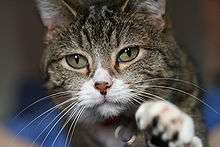
To aid with navigation and sensation, cats have dozens of movable whiskers (vibrissae) over their body, especially their faces. These provide information on the width of gaps and on the location of objects in the dark, both by touching objects directly and by sensing air currents; they also trigger protective blink reflexes to protect the eyes from damage.[67]:47
Most breeds of cat have a noted fondness for settling in high places, or perching. In the wild, a higher place may serve as a concealed site from which to hunt; domestic cats may strike prey by pouncing from a perch such as a tree branch, as does a leopard.[118] Another possible explanation is that height gives the cat a better observation point, allowing it to survey its territory. During a fall from a high place, a cat can reflexively twist its body and right itself using its acute sense of balance and flexibility.[119] This is known as the cat righting reflex. An individual cat always rights itself in the same way, provided it has the time to do so, during a fall. The height required for this to occur is around 90 cm (3.0 ft). Cats without a tail (e.g. many specimens of the Manx and Cymric breeds) also have this ability, since a cat mostly relies on leg movement and conservation of angular momentum to set up for landing, and the tail is little used for this feat.[120] Their excellent sense of balance allows cats to move with great stability. A cat falling from heights of up to 3 meters can right itself and land on its paws.[121]
Health
The average lifespan of pet cats has risen in recent years. In the early 1980s, it was about seven years,[122]:33[123] rising to 9.4 years in 1995[122]:33 and 15.1 years in 2018.[124] However, cats have been reported as surviving into their 30s,[125] with the oldest known cat, Creme Puff, dying at a verified age of 38.[126]
Spaying or neutering increases life expectancy: one study found neutered male cats live twice as long as intact males, while spayed female cats live 62% longer than intact females.[122]:35 Having a cat neutered confers health benefits, because castrated males cannot develop testicular cancer, spayed females cannot develop uterine or ovarian cancer, and both have a reduced risk of mammary cancer.[127]
Despite widespread concern about the welfare of free-roaming cats, the lifespans of neutered feral cats in managed colonies compare favorably with those of pet cats.[128]:45[129]:1358 [130][131][132][133]
Diseases
A wide range of health problems may affect cats, including infectious diseases, parasites, injuries, and chronic disease. Vaccinations are available for many of these diseases, and domestic cats are regularly given treatments to eliminate parasites such as worms and fleas.[134]
Genetics
The domesticated cat and its closest wild ancestor are both diploid organisms that possess 38 chromosomes[135] and roughly 20,000 genes.[136] About 250 heritable genetic disorders have been identified in cats, many similar to human inborn errors.[137] The high level of similarity among the metabolism of mammals allows many of these feline diseases to be diagnosed using genetic tests that were originally developed for use in humans, as well as the use of cats as animal models in the study of the human diseases.[138][139]
Behavior
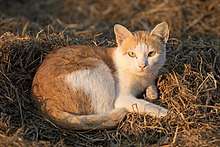
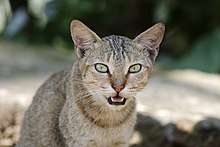
Outdoor cats are active both day and night, although they tend to be slightly more active at night.[140][141] The timing of cats' activity is quite flexible and varied, which means house cats may be more active in the morning and evening, as a response to greater human activity at these times.[142] Although they spend the majority of their time in the vicinity of their home, housecats can range many hundreds of meters from this central point, and are known to establish territories that vary considerably in size, in one study ranging from 7 to 28 hectares (17–69 acres).[141]
Cats conserve energy by sleeping more than most animals, especially as they grow older. The daily duration of sleep varies, usually between 12 and 16 hours, with 13 and 14 being the average. Some cats can sleep as much as 20 hours. The term "cat nap" for a short rest refers to the cat's tendency to fall asleep (lightly) for a brief period. While asleep, cats experience short periods of rapid eye movement sleep often accompanied by muscle twitches, which suggests they are dreaming.[143]
Sociability
Although wildcats are solitary, the social behavior of domestic cats is much more variable and ranges from widely dispersed individuals to feral cat colonies that gather around a food source, based on groups of co-operating females.[144][145] Within such groups, one cat is usually dominant over the others.[35] Each cat in a colony holds a distinct territory, with sexually active males having the largest territories, which are about 10 times larger than those of female cats and may overlap with several females' territories.[111] These territories are marked by urine spraying, by rubbing objects at head height with secretions from facial glands, and by defecation.[111] Between these territories are neutral areas where cats watch and greet one another without territorial conflicts. Outside these neutral areas, territory holders usually chase away stranger cats, at first by staring, hissing, and growling and, if that does not work, by short but noisy and violent attacks. Despite some cats cohabiting in colonies, they do not have a social survival strategy, or a pack mentality and always hunt alone.[146]
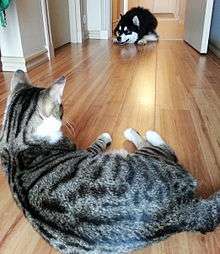
However, some pet cats are poorly socialized. In particular, older cats may show aggressiveness towards newly arrived kittens, which may include biting and scratching; this type of behavior is known as feline asocial aggression.[147]
Though cats and dogs are often characterized as natural enemies, they can live together if correctly socialized.[148]
Life in proximity to humans and other domestic animals has led to a symbiotic social adaptation in cats, and cats may express great affection toward humans or other animals. Ethologically, the human keeper of a cat may function as a sort of surrogate for the cat's mother,[149] and adult housecats live their lives in a kind of extended kittenhood,[150] a form of behavioral neoteny. The high-pitched sounds housecats make to solicit food may mimic the cries of a hungry human infant, making them particularly difficult for humans to ignore.[151]
Domestic cats' scent rubbing behavior towards humans or other cats is thought to be a feline means for social bonding.[152]
Communication
Domestic cats use many vocalizations for communication, including purring, trilling, hissing, growling/snarling, grunting, and several different forms of meowing.[8] By contrast, feral cats are generally silent.[153]:208 Their types of body language, including position of ears and tail, relaxation of the whole body, and kneading of the paws, are all indicators of mood. The tail and ears are particularly important social signal mechanisms in cats;[154][155] for example, a raised tail acts as a friendly greeting, and flattened ears indicates hostility. Tail-raising also indicates the cat's position in the group's social hierarchy, with dominant individuals raising their tails less often than subordinate animals.[155] Nose-to-nose touching is also a common greeting and may be followed by social grooming, which is solicited by one of the cats raising and tilting its head.[145]
Purring may have developed as an evolutionary advantage as a signalling mechanism of reassurance between mother cats and nursing kittens. Post-nursing cats often purr as a sign of contentment: when being petted, becoming relaxed,[156][157] or eating. The mechanism by which cats purr is elusive. The cat has no unique anatomical feature that is clearly responsible for the sound.[158] It was until recent times, believed that only the cats of the Felis genus could purr. However, felids of the genus Panthera (tiger, lion, jaguar, and leopard) also produce non-continuous sounds, called chuffs, similar to purring, but only when exhaling.[159]
Grooming
Cats are known for spending considerable amounts of time licking their coats to keep them clean.[160] The cat's tongue has backwards-facing spines about 500 μm long, which are called papillae. These contain keratin which makes them rigid[161] so the papillae act like a hairbrush. Some cats, particularly longhaired cats, occasionally regurgitate hairballs of fur that have collected in their stomachs from grooming. These clumps of fur are usually sausage-shaped and about 2–3 cm (0.8–1.2 in) long. Hairballs can be prevented with remedies that ease elimination of the hair through the gut, as well as regular grooming of the coat with a comb or stiff brush.[160]
Fighting
Among domestic cats, males are more likely to fight than females.[162] Among feral cats, the most common reason for cat fighting is competition between two males to mate with a female. In such cases, most fights are won by the heavier male.[163] Another common reason for fighting in domestic cats is the difficulty of establishing territories within a small home.[162] Female cats also fight over territory or to defend their kittens. Neutering will decrease or eliminate this behavior in many cases, suggesting that the behavior is linked to sex hormones.[164]
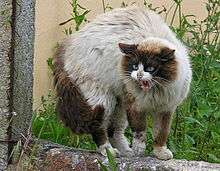
When cats become aggressive, they try to make themselves appear larger and more threatening by raising their fur, arching their backs, turning sideways and hissing or spitting.[154] Often, the ears are pointed down and back to avoid damage to the inner ear and potentially listen for any changes behind them while focused forward. They may also vocalize loudly and bare their teeth in an effort to further intimidate their opponent. Fights usually consist of grappling and delivering powerful slaps to the face and body with the forepaws as well as bites. Cats also throw themselves to the ground in a defensive posture to rake their opponent's belly with their powerful hind legs.[165]
Serious damage is rare, as the fights are usually short in duration, with the loser running away with little more than a few scratches to the face and ears. However, fights for mating rights are typically more severe and injuries may include deep puncture wounds and lacerations. Normally, serious injuries from fighting are limited to infections of scratches and bites, though these can occasionally kill cats if untreated. In addition, bites are probably the main route of transmission of feline immunodeficiency virus.[166] Sexually active males are usually involved in many fights during their lives, and often have decidedly battered faces with obvious scars and cuts to their ears and nose.[167]
Hunting and feeding
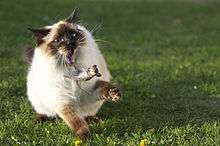
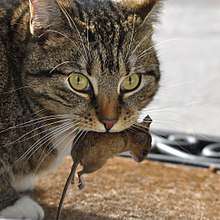
Cats hunt small prey, primarily birds and rodents,[168] and are often used as a form of pest control.[169][170] Domestic cats are a major predator of wildlife in the United States, killing an estimated 1.4 to 3.7 billion birds and 6.9 to 20.7 billion mammals annually.[171][172] The bulk of predation in the United States is done by 80 million feral and stray cats. Effective measures to reduce this population are elusive, meeting opposition from cat enthusiasts.[171][172] In the case of free-ranging pets, equipping cats with bells and not letting them out at night will reduce wildlife predation.[168]
Free-fed feral cats and house cats tend to consume many small meals in a single day, although the frequency and size of meals varies between individuals.[146] Cats use two hunting strategies, either stalking prey actively, or waiting in ambush until an animal comes close enough to be captured.[173] Although it is not certain, the strategy used may depend on the prey species in the area, with cats waiting in ambush outside burrows, but tending to actively stalk birds.[174]:153
Perhaps the best known element of cats' hunting behavior, which is commonly misunderstood and often appalls cat owners because it looks like torture, is that cats often appear to "play" with prey by releasing it after capture. This behavior is due to an instinctive imperative to ensure that the prey is weak enough to be killed without endangering the cat.[175] This behavior is referred to in the idiom "cat-and-mouse game" or simply "cat and mouse".
Another poorly understood element of cat hunting behavior is the presentation of prey to human guardians. Ethologist Paul Leyhausen proposed that cats adopt humans into their social group and share excess kill with others in the group according to the dominance hierarchy, in which humans are reacted to as if they are at, or near, the top.[176] Anthropologist and zoologist Desmond Morris, in his 1986 book Catwatching, suggests, when cats bring home mice or birds, they are attempting to teach their human to hunt, or trying to help their human as if feeding "an elderly cat, or an inept kitten".[177][178] Morris's hypothesis is inconsistent with the fact that male cats also bring home prey, despite males having negligible involvement with raising kittens.[174]:153
Domestic cats select food based on its temperature, smell and texture; they dislike chilled foods and respond most strongly to moist foods rich in amino acids, which are similar to meat.[86][146] Cats may reject novel flavors (a response termed neophobia) and learn quickly to avoid foods that have tasted unpleasant in the past.[146] They may also avoid sugary foods and milk. Most adult cats are lactose intolerant; the sugars in milk are not easily digested and may cause soft stools or diarrhea.[146][179] They can also develop odd eating habits. Some cats like to eat or chew on other things, most commonly wool, but also plastic, cables, paper, string, aluminum foil, or even coal. This condition, pica, can threaten their health, depending on the amount and toxicity of the items eaten.[180][181]
Though cats usually prey on animals less than half their size, a feral cat in Australia has been photographed killing an adult pademelon of around the cat's weight at 4 kg (8.8 lb).[182]
Since cats lack sufficient lips to create suction,[183] they use a lapping method with the tongue to draw liquid upwards into their mouths. Lapping at a rate of four times a second, the cat touches the smooth tip of its tongue to the surface of the water, and quickly retracts it like a corkscrew, drawing water upwards.[184]
Running
A veterinarian and columnist for Mercola Healthy Pets, Karen Shaw Becker, has compiled a list of the fastest and most athletic cat breeds. First is the Egyptian Mau, which can clock up to 30 miles per hour, faster than any other domestic cat breed in the world.[185] In descending order, Becker lists the other swift domestic cats: the Abyssinian cat, the Somali cat, the Bengal cat, the Savannah cat, the Manx cat ("He can jump and accelerate through the house like there's no tomorrow. Watch for his sharp turns and quick stops – you'll think he's a mini sports car in the shape of a cat."), the Siamese cat, the Ocicat, and the Oriental Shorthair.
The average house cat can outspeed the average house dog (excluding those born to run and race, such as the greyhound and the cheetah), but they excel at sprinting, not at long-distance running.
Play
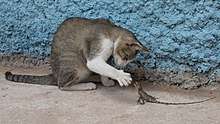
Domestic cats, especially young kittens, are known for their love of play. This behavior mimics hunting and is important in helping kittens learn to stalk, capture, and kill prey.[186] Cats also engage in play fighting, with each other and with humans. This behavior may be a way for cats to practice the skills needed for real combat, and might also reduce any fear they associate with launching attacks on other animals.[187]
Owing to the close similarity between play and hunting, cats prefer to play with objects that resemble prey, such as small furry toys that move rapidly, but rapidly lose interest (they become habituated) in a toy they have played with before.[188] Cats also tend to play with toys more when they are hungry.[189] String is often used as a toy, but if it is eaten, it can become caught at the base of the cat's tongue and then move into the intestines, a medical emergency which can cause serious illness, even death.[190] Owing to the risks posed by cats eating string, it is sometimes replaced with a laser pointer's dot, which cats may chase.[191]
Reproduction
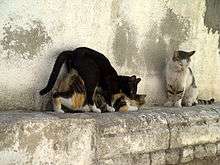
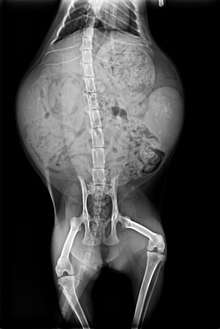
Female cats are seasonally polyestrous, which means they may have many periods of heat over the course of a year, the season beginning in spring and ending in late autumn. Heat periods occur about every two weeks and last about 4 to 7 days.[192] Multiple males will be attracted to a female in heat. The males will fight over her, and the victor wins the right to mate. At first, the female rejects the male, but eventually the female allows the male to mate. The female utters a loud yowl as the male pulls out of her because a male cat's penis has a band of about 120–150 backwards-pointing penile spines, which are about 1 mm long; upon withdrawal of the penis, the spines rake the walls of the female's vagina, which acts to induce ovulation. This act also occurs to clear the vagina of other sperm in the context of a second (or more) mating, thus giving the later males a larger chance of conception.[193]
After mating, the female washes her vulva thoroughly. If a male attempts to mate with her at this point, the female will attack him. After about 20 to 30 minutes, once the female is finished grooming, the cycle will repeat.[192]
Because ovulation is not always triggered by a single mating, females may not be impregnated by the first male with which they mate.[194] Furthermore, cats are superfecund; that is, a female may mate with more than one male when she is in heat, with the result that different kittens in a litter may have different fathers.[192]
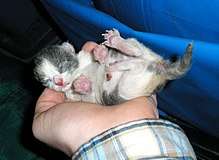
At 124 hours after conception, the morula forms. At 148 hours, early blastocysts form. At 10–12 days, implantation occurs.[195][196]
The gestation period for cats is between 64 and 67 days, with an average of 66 days.[197] The size of a litter usually is three to five kittens, with the first litter usually smaller than subsequent litters. Kittens are weaned between six and seven weeks old, and cats normally reach sexual maturity at 5–10 months (females) and at 5–7 months (males), although this can vary depending on breed. Females can have two to three litters per year, so may produce up to 150 kittens in their breeding span of around ten years.[192]
Cats are ready to go to new homes at about 12 weeks of age,[198] when they are ready to leave their mother. They can be surgically sterilized (spayed or castrated) as early as 7 weeks to limit unwanted reproduction.[199] This surgery also prevents undesirable sex-related behavior, such as aggression, territory marking (spraying urine) in males and yowling (calling) in females. Traditionally, this surgery was performed at around six to nine months of age, but it is increasingly being performed before puberty, at about three to six months.[200] In the US, about 80% of household cats are neutered.[201]
Ecology
Habitats

Cats are a cosmopolitan species and are found across much of the world.[40] Geneticist Stephen James O'Brien, of the National Cancer Institute in Frederick, Maryland, remarked on how successful cats have been in evolutionary terms: "Cats are one of evolution's most charismatic creatures. They can live on the highest mountains and in the hottest deserts."[202] They are extremely adaptable and are now present on all continents except Antarctica, and on 118 of the 131 main groups of islands—even on isolated islands such as the Kerguelen Islands.[203][204]
Feral cats can live in forests, grasslands, tundra, coastal areas, agricultural land, scrublands, urban areas, and wetlands.[205] Their habitats even include small oceanic islands with no human inhabitants.[206] Further, the close relatives of domestic cats, the African wildcat (Felis silvestris lybica) and the Arabian sand cat (Felis margarita) both inhabit desert environments,[30] and domestic cats still show similar adaptations and behaviors.[33] The cat's ability to thrive in almost any terrestrial habitat has led to its designation as one of the world's worst invasive species.[207]
As domestic cats are little altered from wildcats, they can readily interbreed. This hybridization poses a danger to the genetic distinctiveness of some wildcat populations, particularly in Scotland and Hungary and possibly also the Iberian Peninsula.[43]
Feral cats

Feral cats are domestic cats that were born in or have reverted to a wild state. They are unfamiliar with and wary of humans and roam freely in urban and rural areas.[10] The numbers of feral cats is not known, but estimates of the US feral population range from 25 to 60 million.[10] Feral cats may live alone, but most are found in large colonies, which occupy a specific territory and are usually associated with a source of food.[208] Famous feral cat colonies are found in Rome around the Colosseum and Forum Romanum, with cats at some of these sites being fed and given medical attention by volunteers.[209]
Public attitudes towards feral cats vary widely, ranging from seeing them as free-ranging pets, to regarding them as vermin.[210] One common approach to reducing the feral cat population is termed 'trap-neuter-return', where the cats are trapped, neutered, immunized against diseases such as rabies and the feline Panleukopenia and Leukemia viruses, and then released.[211] Before releasing them back into their feral colonies, the attending veterinarian often nips the tip off one ear to mark it as neutered and inoculated, since these cats may be trapped again. Volunteers continue to feed and give care to these cats throughout their lives. Given this support, their lifespans are increased, and behavior and nuisance problems caused by competition for food are reduced.[208]
Impact on prey species
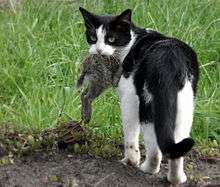
To date, little scientific data is available to assess the impact of cat predation on prey populations outside of agricultural situations. Even well-fed domestic cats may hunt and kill, mainly catching small mammals, but also birds, amphibians, reptiles, fish, and invertebrates.[168][212] Hunting by domestic cats may be contributing to the decline in the numbers of birds in urban areas, although the importance of this effect remains controversial.[213] In the wild, the introduction of feral cats during human settlement can threaten native species with extinction.[206] In many cases, controlling or eliminating the populations of non-native cats can produce a rapid recovery in native animals.[214] However, the ecological role of introduced cats can be more complicated. For example, cats can control the numbers of rats, which also prey on birds' eggs and young, so a cat population can protect an endangered bird species by suppressing mesopredators.[215]
In isolated landmasses, such as Australasia, there are often no other native, medium-sized quadrupedal predators (including other feline species); this tends to exacerbate the impact of feral cats on small native animals.[216] Native species such as the New Zealand kakapo and the Australian bettong, for example, tend to be more ecologically vulnerable and behaviorally "naive", when faced with predation by cats.[217] Feral cats have had a major impact on these native species and have played a leading role in the endangerment and extinction of many animals.[218]
Even in places with ancient and numerous cat populations, such as Western Europe, cats appear to be growing in number and independently of their environments' carrying capacity (such as the numbers of prey available).[219][220] This may be explained, at least in part, by an abundance of food, from sources including feeding by pet owners and scavenging. For instance, research in Britain suggests that a high proportion of cats hunt only "recreationally",[220] and in South Sweden, where research in 1982 found that the population density of cats was as high as 2,000 per square kilometre (5,200/sq mi).[219]
In agricultural settings, cats can be effective at keeping mouse and rat populations low, but only if rodent harborage locations are kept under control.[221][222] While cats are effective at preventing rodent population explosions, they are not effective for eliminating pre-existing severe infestations.[223]
Impact on birds
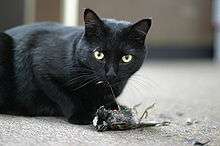
The domestic cat is a significant predator of birds. UK assessments indicate they may be accountable for an estimated 64.8 million bird deaths each year.[168] A 2012 study suggests feral cats may kill several billion birds each year in the United States.[224] Certain species appear more susceptible than others; for example, 30% of house sparrow mortality is linked to the domestic cat.[225] In the recovery of ringed robins (Erithacus rubecula) and dunnocks (Prunella modularis), 31% of deaths were a result of cat predation.[226] In parts of North America, the presence of larger carnivores such as coyotes which prey on cats and other small predators reduces the effect of predation by cats and other small predators such as opossums and raccoons on bird numbers and variety.[227] The proposal that cat populations will increase when the numbers of these top predators decline is called the mesopredator release hypothesis.
On islands, birds can contribute as much as 60% of a cat's diet.[228] In nearly all cases, however, the cat cannot be identified as the sole cause for reducing the numbers of island birds, and in some instances, eradication of cats has caused a 'mesopredator release' effect;[229] where the suppression of top carnivores creates an abundance of smaller predators that cause a severe decline in their shared prey. Domestic cats are, however, known to be a contributing factor to the decline of many species, a factor that has ultimately led, in some cases, to extinction. The South Island piopio, Chatham rail,[226] the New Zealand merganser,[230] and the common diving petrel[231] are a few from a long list, with the most extreme case being the flightless Lyall's wren, which was driven to extinction only a few years after its discovery.[232][233]
Some of the same factors that have promoted adaptive radiation of island avifauna over evolutionary time appear to promote vulnerability to non-native species in modern time. The susceptibility of many island birds is undoubtedly due to evolution in the absence of mainland predators, competitors, diseases, and parasites, in addition to lower reproductive rates and extended incubation periods.[234] The loss of flight, or reduced flying ability is also characteristic of many island endemics.[235] These biological aspects have increased vulnerability to extinction in the presence of introduced species, such as the domestic cat.[236] Equally, behavioral traits exhibited by island species, such as "predatory naivety"[237] and ground-nesting,[234] have also contributed to their susceptibility.
Interaction with humans
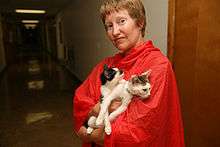
Cats are common pets throughout the world, and their worldwide population exceeds 500 million.[14] Although cat guardianship has commonly been associated with women,[238] a 2007 Gallup poll reported that men and women in the United States of America were equally likely to own a cat.[239]
As well as being kept as pets, cats are also used in the international fur[240] and leather industries for making coats, hats, blankets, and stuffed toys;[241] and shoes, gloves, and musical instruments respectively[242] (about 24 cats are needed to make a cat-fur coat).[243] This use has been outlawed in the United States, Australia, and the European Union.[244] Cat pelts have been used for superstitious purposes as part of the practise of witchcraft,[245] and are still made into blankets in Switzerland as folk remedies believed to help rheumatism.[246] In the Western intellectual tradition, the idea of cats as everyday objects have served to illustrate problems of quantum mechanics in the Schrödinger's cat thought experiment.
A few attempts to build a cat census have been made over the years, both through associations or national and international organizations (such as the Canadian Federation of Humane Societies's one[247]) and over the Internet,[248][249] but such a task does not seem simple to achieve. General estimates for the global population of domestic cats range widely from anywhere between 200 million to 600 million.[250][251][252][253][254][255]
Cat show
A cat show is a judged event in which the owners of cats compete to win titles in various cat registering organizations by entering their cats to be judged after a breed standard.[256][257] Both pedigreed and companion (or moggy) cats are admissible, although the rules differ from organization to organization. Cats are compared to a breed standard,[258] and the owners of those judged to be closest to it are awarded a prize. Moggies are judged based on their temperament. Often, at the end of the year, all of the points accrued at various shows are added up and more national and regional titles are awarded.
Cat café
A cat café is a theme café whose attraction is cats that can be watched and played with.[259]
Ailurophobia
Ailurophobia is a human phobia of cats; however, the term is often associated with humans that have a hatred of cats.[260]
Cat bites
Cats may bite humans when provoked, during play or when aggressive. Complications from cat bites can develop.[261] A cat bite differs from the bites of other pets. This is because the teeth of a cat are sharp and pointed causing deep punctures. Skin usually closes rapidly over the bite and traps microorganisms that cause infection.[262][261]
Infections transmitted from cats to humans
Cats can be infected or infested with viruses, bacteria, fungus, protozoans, arthropods or worms that can transmit diseases to humans.[263] In some cases, the cat exhibits no symptoms of the disease,[264] However, the same disease can then become evident in a human. The likelihood that a person will become diseased depends on the age and immune status of the person. Humans who have cats living in their home or in close association are more likely to become infected, however, those who do not keep cats as pets might also acquire infections from cat feces and parasites exiting the cat's body.[263][265] Some of the infections of most concern include salmonella, cat-scratch disease and toxoplasmosis.[264]
History and mythology


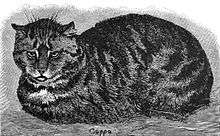
Traditionally, historians tended to think ancient Egypt was the site of cat domestication, owing to the clear depictions of house cats in Egyptian paintings about 3,600 years old.[30] However, in 2004, a Neolithic grave excavated in Shillourokambos, Cyprus, contained the skeletons, laid close to one another, of both a human and a cat. The grave is estimated to be 9,500 years old, pushing back the earliest known feline–human association significantly.[17][267][268] The cat specimen is large and closely resembles the African wildcat, rather than present-day domestic cats. This discovery, combined with genetic studies, suggests cats were probably domesticated in the Middle East, in the Fertile Crescent around the time of the development of agriculture, and then were brought to Cyprus and Egypt.[16][21] Direct evidence for the domestication of cats 5,300 years ago in Quanhucun, China has been published by archaeologists and paleontologists from the University of Washington and Chinese Academy of Sciences. The cats are believed to have been attracted to the village by rodents, which in turn were attracted by grain cultivated and stored by humans.[269]
In ancient Egypt, cats were sacred animals, with the goddess Bastet often depicted in cat form, sometimes taking on the war-like aspect of a lioness.[270]:220 Killing a cat was absolutely forbidden[266] and the Greek historian Herodotus reports that, whenever a household cat died, the entire family would mourn and shave their eyebrows.[266] Families took their dead cats to the sacred city of Bubastis,[266] where they were embalmed and buried in sacred repositories.[266] Domestic cats were probably first introduced to Greece and southern Italy in the fifth century BC by the Phoenicians.[271] The earliest unmistakable evidence of the Greeks having domestic cats comes from two coins from Magna Graecia dating to the mid-fifth century BC showing Iokastos and Phalanthos, the legendary founders of Rhegion and Taras respectively, playing with their pet cats.[272]:57–58[273]
Housecats seem to have been extremely rare among the ancient Greeks and Romans;[273] Herodotus expressed astonishment at the domestic cats in Egypt, because he had only ever seen wildcats.[273] Even during later times, weasels were far more commonly kept as pets[273] and weasels, not cats, were seen as the ideal rodent-killers.[273] The usual ancient Greek word for "cat" was ailouros, meaning "thing with the waving tail",[272]:57[273] but this word could also be applied to any of the "various long-tailed carnivores kept for catching mice".[273] Cats are rarely mentioned in ancient Greek literature,[273] but Aristotle does remark in his History of Animals that "female cats are naturally lecherous."[272]:74[273] The Greeks later syncretized their own goddess Artemis with the Egyptian goddess Bastet, adopting Bastet's associations with cats and ascribing them to Artemis.[272]:77–79 In Ovid's Metamorphoses, when the gods flee to Egypt and take animal forms, the goddess Diana (the Roman equivalent of Artemis) turns into a cat.[272]:79 Cats eventually displaced ferrets as the pest control of choice because they were more pleasant to have around the house and were more enthusiastic hunters of mice.[274] During the Middle Ages, many of Artemis's associations with cats were grafted onto the Virgin Mary.[274] Cats are often shown in icons of Annunciation and of the Holy Family[274] and, according to Italian folklore, on the same night that Mary gave birth to Jesus, a virgin cat in Bethlehem gave birth to a kitten.[274] Domestic cats were spread throughout much of the rest of the world during the Age of Discovery, as ships' cats were carried on sailing ships to control shipboard rodents and as good-luck charms.[270]:223
Several ancient religions believed cats are exalted souls, companions or guides for humans, that are all-knowing but mute so they cannot influence decisions made by humans. In Japan, the maneki neko cat is a symbol of good fortune.[275] In Norse mythology, Freyja, the goddess of love, beauty, and fertility, is depicted as riding a chariot drawn by cats.[276] In Jewish legend, the first cat was living in the house of the first man Adam as a pet that got rid of mice.[277] The cat was once partnering with the first dog before the latter broke an oath they had made which resulted in enmity between the descendants of these two animals.[277] It is also written that neither cats nor foxes are represented in the water, while every other animal has an incarnation species in the water.[277] Although no species are sacred in Islam, cats are revered by Muslims. Some Western writers have stated Muhammad had a favorite cat, Muezza.[278] He is reported to have loved cats so much, "he would do without his cloak rather than disturb one that was sleeping on it".[279] The story has no origin in early Muslim writers, and seems to confuse a story of a later Sufi saint, Ahmed ar-Rifa'i, centuries after Muhammad.[280] One of the companions of Muhammad was known as "Abu Hurayrah" (Father of the Kitten), in reference to his documented affection to cats.[281]
Superstitions and cat burning

Many cultures have negative superstitions about cats. An example would be the belief that a black cat "crossing one's path" leads to bad luck, or that cats are witches' familiars used to augment a witch's powers and skills. The killing of cats in Medieval Ypres, Belgium, is commemorated in the innocuous present-day Kattenstoet (cat parade).[282] In medieval France, cats would be burnt alive as a form of entertainment. According to Norman Davies, the assembled people "shrieked with laughter as the animals, howling with pain, were singed, roasted, and finally carbonized".[283]
"It was the custom to burn a basket, barrel, or sack full of live cats, which was hung from a tall mast in the midst of the bonfire; sometimes a fox was burned. The people collected the embers and ashes of the fire and took them home, believing that they brought good luck. The French kings often witnessed these spectacles and even lit the bonfire with their own hands. In 1648 Louis XIV, crowned with a wreath of roses and carrying a bunch of roses in his hand, kindled the fire, danced at it and partook of the banquet afterwards in the town hall. But this was the last occasion when a monarch presided at the midsummer bonfire in Paris. At Metz midsummer fires were lighted with great pomp on the esplanade, and a dozen cats, enclosed in wicker cages, were burned alive in them, to the amusement of the people. Similarly at Gap, in the department of the Hautes-Alpes, cats used to be roasted over the midsummer bonfire."[284]
According to a myth in many cultures, cats have multiple lives. In many countries, they are believed to have nine lives, but in Italy, Germany, Greece, Brazil and some Spanish-speaking regions, they are said to have seven lives,[285][286] while in Turkish and Arabic traditions, the number of lives is six.[287] The myth is attributed to the natural suppleness and swiftness cats exhibit to escape life-threatening situations. Also lending credence to this myth is the fact that falling cats often land on their feet, using an instinctive righting reflex to twist their bodies around. Nonetheless, cats can still be injured or killed by a high fall.[288]
See also
- Aging in cats
- Animal testing on cats
- Animal track
- Cancer in cats
- Cat and mouse (cat-and-mouse game)
- Cat burning
- Cat intelligence
- Cat lady
- Cats and the Internet
- Dog–cat relationship
- Dried cat
- List of cat breeds
- List of cat documentaries
- List of cats
- List of fictional cats and felines
- Pet door including cat flap
- Pet first aid
- Popular cat names
- Trap-neuter-return
- Cats by location
Notes
References
- 1 2 3 4 5 6 Wozencraft, W.C. (2005). "Species Felis catus". In Wilson, D.E.; Reeder, D.M. Mammal Species of the World: A Taxonomic and Geographic Reference (3rd ed.). Johns Hopkins University Press. pp. 534–535. ISBN 978-0-8018-8221-0. OCLC 62265494.
- 1 2 Linnaeus, Carl (1758). Systema naturae (in Latin). 1 (10th ed.). Stockholm: Lars Salvius. p. 42. Archived from the original on 31 August 2017. Retrieved 4 September 2017 – via Biodiversity Heritage Library.
- ↑ "ITIS Standard Report Page: Felis catus domestica". ITIS Online Database. Archived from the original on 19 January 2012. Retrieved 14 December 2011.
- ↑ "Felis silvestris catus - Wiktionary". en.wiktionary.org.
- ↑ "ITIS Standard Report Page: Felis catus". ITIS Online Database. Reston, Virginia: Integrated Taxonomic Information System. 2011. Archived from the original on 10 January 2012. Retrieved 14 December 2011.
- ↑ Housecat. American Heritage Dictionary of the English Language. Boston: Houghton Mifflin. 2010. Archived from the original on 18 July 2011. Retrieved 6 October 2010 – via Yahoo.com.
- ↑ "Felis catus". www.sms.si.edu.
- 1 2 Moelk, Mildred (April 1944). "Vocalizing in the House-cat; A Phonetic and Functional Study". The American Journal of Psychology. 57 (2): 184–205. doi:10.2307/1416947. JSTOR 1416947.
- ↑ Tucker, Abigail (2016). The Lion in the Living Room: How House Cats Tamed Us and Took Over the World. Simon & Schuster. ISBN 978-1476738239. Archived from the original on 14 November 2016. Retrieved 13 November 2016.
- 1 2 3 Rochlitz, Irene (2007). The Welfare of Cats. "Animal Welfare" series. Berlin: Springer Science+Business Media. pp. 141–175. ISBN 978-1-4020-6143-1.
- ↑ Impact of Feral Cats in Australia Archived 20 July 2015 at the Wayback Machine.
- ↑ "Cats Responsible For Driving Many Species To Extinction". IFLScience. Retrieved 6 June 2018.
- ↑ Winters, L.; Walter, G. E. (May 2006). "Impacts of Feral and Free-ranging Cats on Bird Species of Conservation Concern" (PDF). ABCBirds.org. American Bird Conservancy. Archived (PDF) from the original on 13 April 2015.
- 1 2 3 4 Wade, Nicholas (2007). "Study Traces Cat's Ancestry to Middle East". The New York Times. Archived from the original on 18 April 2009. Retrieved 2 April 2008.
- ↑ Vigne, J. D.; Guilaine, J.; Debue, K.; Haye, L.; Gérard, P. (2004). "Early taming of the cat in Cyprus". Science. 304 (5668): 259. doi:10.1126/science.1095335. PMID 15073370.
- 1 2 Driscoll, C. A.; Menotti-Raymond, M.; Roca, A. L.; Hupe, K.; Johnson, W. E.; Geffen, E.; Harley, E. H.; Delibes, M.; Pontier, D.; Kitchener, A. C.; Yamaguchi, N.; O'Brien, S. J.; Macdonald, D. W. (2007). "The Near Eastern Origin of Cat Domestication". Science. 317 (5837): 519–523. Bibcode:2007Sci...317..519D. doi:10.1126/science.1139518. ISSN 0036-8075. PMC 5612713. PMID 17600185.
- 1 2 3 "Oldest Known Pet Cat? 9,500-year-old Burial Found on Cyprus". National Geographic News. National Geographic Society. 2004. Archived from the original on 3 March 2007. Retrieved 6 March 2007.
- ↑ Vigne, J.-D.; Evin, A.; Cucchi, T.; Dai, L.; Yu, C.; Hu, S.; Soulages, N.; Wang, W.; Sun, Z. (2016). "Earliest 'Domestic' Cats in China Identified as Leopard Cat (Prionailurus bengalensis)". PLOS One. 11 (1): e0147295. Bibcode:2016PLoSO..1147295V. doi:10.1371/journal.pone.0147295. PMC 4723238. PMID 26799955.
- ↑ Grimm, David (27 January 2016). "Were cats domesticated more than once?". sciencemag.org. Archived from the original on 27 January 2016. Retrieved 27 January 2016.
- ↑ Sample, Ian (19 June 2017). "Africats to the Purr-ymids: DNA study reveals long tale of cat domestication". The Guardian. Archived from the original on 19 June 2017. Retrieved 19 June 2017.
- 1 2 Ottoni, Claudio; Van Neer, Wim; De Cupere, Bea; Daligault, Julien; Guimaraes, Silvia; Peters, Joris; Spassov, Nikolai; Prendergast, Mary E.; Boivin, Nicole; Morales-Muñiz, Arturo; Bălăşescu, Adrian; Becker, Cornelia; Benecke, Norbert; Boroneant, Adina; Buitenhuis, Hijlke; Chahoud, Jwana; Crowther, Alison; Llorente, Laura; Manaseryan, Nina; Monchot, Hervé; Onar, Vedat; Osypińska, Marta; Putelat, Olivier; Quintana Morales, Eréndira M.; Studer, Jacqueline; Wierer, Ursula; Decorte, Ronny; Grange, Thierry; Geigl, Eva-Maria (2017). "The palaeogenetics of cat dispersal in the ancient world". Nature Ecology & Evolution. 1 (7): 0139. doi:10.1038/s41559-017-0139. ISSN 2397-334X.
- ↑ Thompson, Andrea. "What's the Most Popular Pet?". LiveScience. Archived from the original on 22 December 2015. Retrieved 15 December 2015.
- ↑ "Statistics about pets in the UK" Archived 26 December 2012 at the Wayback Machine.. 2010, Society for Companion Animal Studies. Retrieved 15 November 2016
- ↑ Johnson, Warren; O'Brien, Stephen J. (1997). "Phylogenetic Reconstruction of the Felidae Using 16S rRNA and NADH-5 Mitochondrial Genes". Journal of Molecular Evolution (Submitted manuscript). 44 (S1): S98–S116. Bibcode:1997JMolE..44S..98J. doi:10.1007/PL00000060. PMID 9071018.
- ↑ "ITIS Standard Report Page: Felis". ITIS Online Database. Archived from the original on 19 May 2012. Retrieved 14 December 2011.
- ↑ Stefoff, Rebecca (November 2003). Cats. New York: Benchmark Books. p. 34. ISBN 978-0-7614-1577-0.
- ↑ Yamaguchi, N.; Kitchener, A.; Driscoll, C.; Nussberger, B. (2015). "Felis silvestris (Wildcat, Wild Cat)". The IUCN Red List of Threatened Species. Archived from the original on 16 December 2016. Retrieved 24 March 2017.
- ↑ Francis, Richard C. (2015). Domesticated: Evolution in a Man-Made World. W. W. Norton & Company.
- ↑ House Cat Origin Traced to Middle Eastern Wildcat Ancestor Archived 31 January 2017 at the Wayback Machine. Brian Handwerk for National Geographic News, 28 June 2007
- 1 2 3 4 5 6 7 Driscoll, C. A.; MacDonald, D. W.; O'Brien, Stephen J. (2009). "In the Light of Evolution III: Two Centuries of Darwin Sackler Colloquium: From Wild Animals to Domestic Pets – An Evolutionary View of Domestication". Proceedings of the National Academy of Sciences of the United States of America. 106 (S1): 9971–9978. Bibcode:2009PNAS..106.9971D. doi:10.1073/pnas.0901586106. PMC 2702791. PMID 19528637.
- 1 2 3 Wozencraft, W.C. (2005). "Species Felis silvestris". In Wilson, D.E.; Reeder, D.M. Mammal Species of the World: A Taxonomic and Geographic Reference (3rd ed.). Johns Hopkins University Press. pp. 536–537. ISBN 978-0-8018-8221-0. OCLC 62265494.
- ↑ "Opinion 2027". Bulletin of Zoological Nomenclature. 60. 2003. Archived from the original on 9 June 2012.
- 1 2 3 4 5 6 7 MacDonald, M. L.; Rogers, Q. R.; Morris, J. G. (1984). "Nutrition of the domestic cat, a mammalian carnivore". Annual Review of Nutrition. 4: 521–562. doi:10.1146/annurev.nu.04.070184.002513. PMID 6380542.
- ↑ Erxleben, J. C. P. (1777). Systema regni animalis. p. 520. Archived from the original on 4 September 2017 – via Biodiversity Heritage Library.
- 1 2 Baron, Alan; Stewart, C. N.; Warren, J. M. (1 January 1957). "Patterns of Social Interaction in Cats (Felis domestica)". Behaviour. 11 (1): 56–66. doi:10.1163/156853956X00084. JSTOR 4532869.
- ↑ "Catalogue of the Specimens of Caucasian Large Mammalian Fauna in the Collection". National Museum of Georgia. Archived from the original on 21 March 2013. Retrieved 4 July 2013.
- ↑ Johnson, Warren E.; Eizirik, E.; Pecon-Slattery, J.; Murphy, W. J.; Antunes, A.; Teeling, E.; O'Brien, Stephen J. (2006). "The Late Miocene Radiation of Modern Felidae: A Genetic Assessment". Science. 311 (5757): 73–77. Bibcode:2006Sci...311...73J. doi:10.1126/science.1122277. PMID 16400146.
- 1 2 3 Mattern, Michelle Y.; McLennan, Deborah A. (2000). "Phylogeny and Speciation of Felids". Cladistics. 16 (2): 232–253. doi:10.1111/j.1096-0031.2000.tb00354.x.
- ↑ Masuda, R.; Lopez, J. V.; Slattery, J. P.; Yuhki,, N.; O'Brien, Stephen J. (1996). "Molecular Phylogeny of Mitochondrial Cytochrome b and 12S rRNA Sequences in the Felidae: Ocelot and Domestic Cat Lineages". Molecular Phylogenetics and Evolution. 6 (3): 351–365. doi:10.1006/mpev.1996.0085. PMID 8975691.
- 1 2 Lipinski, Monika J.; Froenicke, Lutz; Baysac, Kathleen C.; Billings, Nicholas C.; Leutenegger, Christian M.; Levy, Alon M.; Longeri, Maria; Niini, Tirri; Ozpinar, Haydar (January 2008). "The Ascent of Cat Breeds: Genetic Evaluations of Breeds and Worldwide Random-bred Populations". Genomics. 91 (1): 12–21. doi:10.1016/j.ygeno.2007.10.009. PMC 2267438. PMID 18060738.
- 1 2 3 Cameron-Beaumont, Charlotte; Lowe, Sarah E.; Bradshaw, John W. S. (2002). "Evidence Suggesting Pre-adaptation to Domestication Throughout the Small Felidae" (PDF). Biological Journal of the Linnean Society. 75 (3): 361–366. doi:10.1046/j.1095-8312.2002.00028.x. Archived from the original (PDF) on 9 June 2011. Retrieved 29 September 2009.
- 1 2 Bradshawa, J. W. S.; Horsfield, G. F.; Allen, J. A.; Robinson, I. H. (1999). "Feral Cats: Their Role in the Population Dynamics of Felis catus". Applied Animal Behaviour Science. 65 (3): 273–283. doi:10.1016/S0168-1591(99)00086-6.
- 1 2 Oliveira, R.; Godinho, R.; Randi, E.; Alves, P. C. (2008). "Hybridization Versus Conservation: Are Domestic Cats Threatening the Genetic Integrity of Wildcats (Felis silvestris silvestris) in Iberian Peninsula?". Philosophical Transactions of the Royal Society of London. Series B, Biological Sciences. 363 (1505): 2953–2961. doi:10.1098/rstb.2008.0052. PMC 2606743. PMID 18522917.
- ↑ Fogle, Bruce, ed. (1981). Interrelations Between People and Pets. Charles C. Thomas Publications. ISBN 978-0-398-04169-4.
- ↑ O'Connor, T. P. (2007). "Wild or Domestic? Biometric Variation in the Cat Felis silvestris". International Journal of Osteoarchaeology. 17 (6): 581–595. doi:10.1002/oa.913.
- ↑ Harper, Douglas (ed.). "cat". Online Etymology Dictionary. Archived from the original on 20 September 2007. Retrieved 29 September 2009.
- ↑ McKnight, George H. (1923). English Words and Their Background. New York: D. Appleton and Company. p. 130. Archived from the original on 5 July 2017 – via Questia.
- ↑ "cat". The Oxford English Dictionary. Oxford University Press. Retrieved 1 October 2012.
- 1 2 Huehnergard, John. "Qitta: Arabic Cats". Classical Arabic Humanities in Their Own Terms.
- ↑ Savignac, Jean-Paul (2004). "chat". Dictionnaire français-gaulois. Paris: Errance. p. 82.
- ↑ Kroonen, Guus (2013). Etymological Dictionary of Proto-Germanic. Leiden, Netherlands: Brill Publishers. p. 281f. ISBN 978-90-04-18340-7.
- ↑ "Puss". The Oxford English Dictionary. Oxford University Press. Retrieved 1 October 2012.
- ↑ "puss". Webster's Encyclopedic Unabridged Dictionary of the English Language. New York: Gramercy (Random House). 1996. p. 1571.
- ↑ "What do you call a group of ...?". Oxford Dictionaries Online. Oxford University Press. Archived from the original on 12 October 2012. Retrieved 1 October 2012.
- ↑ "tom cat, tom-cat". The Oxford English Dictionary. Oxford University Press. Retrieved 1 October 2012.
- ↑ "gib, n.2". The Oxford English Dictionary. Retrieved 1 October 2012.
- ↑ "queen cat". The Oxford English Dictionary. Retrieved 1 October 2012.
- ↑ "sire". The Oxford English Dictionary. Retrieved 1 October 2012.
- ↑ "Dam, n.2". The Oxford English Dictionary. Retrieved 1 October 2012.
- ↑ "catling". The Oxford English Dictionary. Retrieved 1 October 2012.
- ↑ Hartwell, Sarah (2002–2011). "Dwarf, Midget and Miniature Cats (Including 'Tea-cup' Cats)". MessyBeast.com. self-published. Archived from the original on 27 February 2015. Retrieved 27 January 2015.
- 1 2 Wilson, Julia (2002–2008). "Cat World Records". Cat-World.com.au. self-published. Archived from the original on 1 August 2008. Retrieved 7 September 2012.
- ↑ "Feline Veterinary care by The Boston Cat Hospital/Feline Fast Cats". Boston Cat Hospital. Archived from the original on 31 October 2012. Retrieved 10 January 2013.
- ↑ "Domestic Cat". Animal Bytes. SeaWorld Parks and Entertainment. 2011. Archived from the original on 17 December 2011. Retrieved 14 December 2011. This tertiary source reuses information from other sources without citing them in detail.
- 1 2 Walker, Warren F. (1982). Study of the Cat with Reference to Human Beings (4th Revised ed.). Thomson Learning (Cengage). ISBN 978-0-03-057914-1.
- ↑ Gillis, Rick, ed. (22 July 2002). "Cat Skeleton". Zoolab. La Crosse: University of Wisconsin. Archived from the original on 6 December 2006. Retrieved 7 September 2012.
- 1 2 3 4 5
- Case, Linda P. (2003). The Cat: Its Behavior, Nutrition, and Health. Ames: Iowa State University Press. ISBN 978-0-8138-0331-9.
- 1 2 Smith, Patricia; Tchernov, Eitan (1992). Structure, Function and Evolution of teeth. Freund Publishing House. p. 217. ISBN 978-965-222-270-1.
- ↑ Carr, William H. A. (1 January 1978). The New Basic Book of the Cat. Scribner's. p. 174. ISBN 978-0-684-15549-4.
- ↑ Lacquaniti, F.; Grasso, R.; Zago, M. (1 August 1999). "Motor Patterns in Walking". News Physiol. Sci. 14 (4): 168–174. PMID 11390844.
- ↑ Christensen, Wendy (2004). Outwitting Cats. Globe Pequot. p. 23. ISBN 978-1-59228-240-1.
- ↑ Russell, Anthony P.; Bryant, Harold N. (2001). "Claw Retraction and Protraction in the Carnivora: The Cheetah (Acinonyx Jubatus) as an Atypical Felid". Journal of Zoology. 254 (1): 67–76. doi:10.1017/S0952836901000565.
- ↑ Armes, Annetta F. (22 December 1900). "Outline of Cat Lessons". The School Journal. LXI: 659. Retrieved 12 November 2007.
- 1 2 Danforth, C. H. (April 1947). "Heredity of polydactyly in the cat" (PDF). The Journal of Heredity. 38 (4): 107–112. doi:10.1093/oxfordjournals.jhered.a105701. PMID 20242531. Archived (PDF) from the original on 3 September 2013.
- ↑ Lettice, L. A.; Hill, A. E.; Devenney, P. S.; Hill, R. E. (April 2008). "Point mutations in a distant sonic hedgehog cis-regulator generate a variable regulatory output responsible for preaxial polydactyly". Human Molecular Genetics. 17 (7): 978–985. doi:10.1093/hmg/ddm370. PMID 18156157.
- ↑ US National Research Council Subcommittee on Dog and Cat Nutrition (2006). Nutrient Requirements of Dogs and Cats. Washington DC: National Academies of Sciences, Engineering, and Medicine. p. 292. ISBN 978-0-309-08628-8.
- ↑ Kahn, Cynthia M.; Line, Scott (2007). Hollander, Joseph Lee, ed. The Merck/Merial Manual for Pet Health. Merck & Co. ISBN 978-0-911910-99-5.
- ↑ "How do cats sweat?". CatHealth.com. Archived from the original on 3 March 2014. Retrieved 24 February 2014.
- ↑ Adams, T.; Morgan, M. L.; Hunter, W. S.; Holmes, K. R. (1970). "Temperature Regulation of the Unanesthetized Cat During Mild Cold and Severe Heat Stress". Journal of Applied Physiology. 29 (6): 852–858. doi:10.1152/jappl.1970.29.6.852. PMID 5485356.
- 1 2 US National Research Council Committee on Animal Nutrition (1986). Nutrient Requirements of Cats (2nd ed.). Washington DC: National Academies of Sciences, Engineering, and Medicine. Archived from the original on 15 August 2010.
- ↑ Prentiss, Phoebe G. (1959). "Hydropenia in Cat and Dog: Ability of the Cat to Meet its Water Requirements Solely from a Diet of Fish or Meat". American Journal of Physiology. 196 (3): 625–632. doi:10.1152/ajplegacy.1959.196.3.625. PMID 13627237.
- ↑ Wolf, A. V. (1959). "Potability of Sea Water with Special Reference to the Cat". American Journal of Physiology. 196 (3): 633–641. doi:10.1152/ajplegacy.1959.196.3.633. PMID 13627238.
- ↑ Fraser, Andrew F. (2012). Feline Behaviour and Welfare. Centre for Agriculture and Bioscience International. p. 107. ISBN 978-1-78064-121-8. Archived from the original on 20 February 2018.
- 1 2 Zoran, D. L. (2002). "The Carnivore Connection to Nutrition in Cats" (PDF). Journal of the American Veterinary Medical Association. 221 (11): 1559–1567. doi:10.2460/javma.2002.221.1559. PMID 12479324. Archived from the original (PDF) on 26 May 2010.
- ↑ Gray, C. M.; Sellon, R. K.; Freeman, L. M. (2004). "Nutritional Adequacy of Two Vegan Diets for Cats". Journal of the American Veterinary Medical Association. 225 (11): 1670–1675. doi:10.2460/javma.2004.225.1670. PMID 15626215.
- 1 2 Zaghini, G.; Biagi, G. (2005). "Nutritional Peculiarities and Diet Palatability in the Cat". Vet. Res. Commun. 29 (Supplement 2): 39–44. doi:10.1007/s11259-005-0009-1. PMID 16244923.
- ↑ "Why Do Cats Eat Grass?". AnimalPlanet.com. 2012-05-15. Archived from the original on 3 April 2017. Retrieved 2 April 2017.
- ↑ Morris, J. G.; Rogers, Q. R. (1 December 1978). "Arginine: An Essential Amino Acid for the Cat". Journal of Nutrition. 108 (12): 1944–1953. doi:10.1093/jn/108.12.1944. PMID 722344.
- 1 2 Bauer, J. (1998). Nutritional Uniqueness of Cats. Veterinary Quarterly,20(Sup1), 78-79.
- ↑ "the definition of amino acid". Dictionary.com. Retrieved 22 February 2017.
- 1 2 3 4 Schullerlevis, G.; Mehta, P.; Rudelli, R.; Sturman, J. (1990). "Immunological Consequences of Taurine Deficiency in Cats". Journal of Leukocyte Biology. 47 (4): 321–331.
- ↑ US National Research Council Subcommittee on Dog and Cat Nutrition (2006). "The Role of Vitamins and Minerals in the Diet for Cats". Nutrient Requirements of Cats and Dogs. Washington DC: National Academies of Sciences, Engineering, and Medicine. ISBN 978-0-309-08628-8. Archived from the original on 7 September 2006.
- 1 2 Morris, J. (2002). "Idiosyncratic nutrient requirements of cats appear to be diet-induced evolutionary adaptations". Nutrition Research Reviews. 15 (1): 153–168. doi:10.1079/nrr200238. PMID 19087402.
- 1 2 3 4 5 MacDonald, M. L.; Rogers, Q. R. (1984). "Nutrition of the domestic cat, a mammalian carnivore". Annual Review of Nutrition. 4: 521–562. doi:10.1146/annurev.nutr.4.1.521.
- ↑ "The Nutritional Requirements of the Cat". Nutrition Reviews. 40 (9): 283–285. 1982. doi:10.1111/j.1753-4887.1982.tb05341.x.
- ↑ Girard, N.; Servet, E.; Hennet, P.; Biourge, V. (2010). "Tooth Resorption and Vitamin D 3 Status in Cats Fed Premium Dry Diets". Journal of Veterinary Dentistry. 27 (3): 142–147. doi:10.1177/089875641002700301. PMID 21038831.
- 1 2 Morris, James G (1999). "Ineffective vitamin D synthesis in cats is reversed by an inhibitor of 7-dehydrocholesterol-delta(super 7)-reductase". The Journal of Nutrition. 129 (4): 903–908. doi:10.1093/jn/129.4.903. PMID 10203568.
- ↑ MacDonald, M. L.; Anderson, B. C.; Rogers, Q. R; Buffington, C. A. (1984). "Essential fatty acid requirements of cats: Pathology of essential fatty acid deficiency". American Journal of Veterinary Research. 45 (7): 1310–1317. Archived from the original on 20 February 2018.
- ↑ Ollivier, F. J.; Samuelson, D. A.; Brooks, D. E.; Lewis, P. A.; Kallberg, M. E.; Komaromy, A. M. (2004). "Comparative Morphology of the Tapetum Lucidum (among Selected Species)". Veterinary Ophthalmology. 7 (1): 11–22. doi:10.1111/j.1463-5224.2004.00318.x. PMID 14738502.
- 1 2 Malmström, T.; Kröger, R. H. (2006). "Pupil shapes and lens optics in the eyes of terrestrial vertebrates". Journal of Experimental Biology. 209 (Pt. 1): 18–25. doi:10.1242/jeb.01959. PMID 16354774.
- ↑ Hammond, P.; Mouat, G. S. V. (1985). "The relationship between feline pupil size and luminance". Experimental Brain Research. 59 (3): 485–490. doi:10.1007/BF00261338.
- ↑ Loop, M. S.; Bruce, L. L. (1978). "Cat Color Vision: The Effect of Stimulus Size". Science. 199 (4334): 1221–1222. Bibcode:1978Sci...199.1221L. doi:10.1126/science.628838. PMID 628838.
- ↑ Guenther, Elke; Zrenner, Eberhart (April 1993). "The Spectral Sensitivity of Dark- and Light-adapted Cat Retinal Ganglion Cells". Journal of Neuroscience. 13 (4): 1543–1550. PMID 8463834. Archived from the original on 13 April 2011.
- 1 2 Heffner, Rickye S. (November 2004). "Primate hearing from a mammalian perspective" (PDF). The Anatomical Record Part A: Discoveries in Molecular, Cellular, and Evolutionary Biology. 281 (1): 1111–1122. doi:10.1002/ar.a.20117. PMID 15472899. Archived from the original (PDF) on 19 September 2006. Retrieved 20 August 2009.
- ↑ Heffner, Henry E. (May 1998). "Auditory awareness". Applied Animal Behaviour Science. 57 (3–4): 259–268. doi:10.1016/S0168-1591(98)00101-4.
- 1 2 Sunquist, Melvin E.; Sunquist, Fiona (2002). Wild Cats of the World. University of Chicago Press. p. 10. ISBN 978-0-226-77999-7.
- ↑ Blumberg, M. S. (1992). "Rodent ultrasonic short calls: locomotion, biomechanics, and communication". Journal of Comparative Psychology. 106 (4): 360–365. doi:10.1037/0735-7036.106.4.360. PMID 1451418.
- ↑ Heffner, Rickye S. (1985). "Hearing range of the domestic cat" (PDF). Hearing Research. 19 (1): 85–88. doi:10.1016/0378-5955(85)90100-5. PMID 4066516. Archived (PDF) from the original on 2 August 2010. Retrieved 20 August 2009.
- ↑ Moulton, David G. (1 August 1967). "Olfaction in mammals". American Zoology. 7 (3): 421–429. doi:10.1093/icb/7.3.421.
- ↑ Miyazaki, M.; Yamashita, T; Suzuki, Y.; Saito, Y.; Soeta, S.; Taira, H.; Suzuki, A. (2006). "A major urinary protein of the domestic cat regulates the production of felinine, a putative pheromone precursor". Chemical Biology. 13 (10): 1071–1079. doi:10.1016/j.chembiol.2006.08.013. PMID 17052611.
- 1 2 3 Sommerville, B. A. (1998). "Olfactory Awareness". Applied Animal Behaviour Science. 57 (3–4): 269–286. doi:10.1016/S0168-1591(98)00102-6.
- ↑ Grognet, Jeff (June 1990). "Catnip: Its uses and effects, past and present". The Canadian Veterinary Journal. 31 (6): 455–456. PMC 1480656. PMID 17423611.
- ↑ Turner, Ramona (29 May 2007). "How does catnip work its magic on cats?". Scientific American. Archived from the original on 22 October 2013.
- ↑ Tucker, Arthur; Tucker, Sharon (1988). "Catnip and the catnip response". Economic Botany. 42 (2): 214–231. doi:10.1007/BF02858923.
- 1 2 Schelling, Christianne. "Do Cats Have a Sense of Taste?". CatHealth.com. Archived from the original on 28 January 2016.
- ↑ "Why Cats Can't Taste Sweets". Petside.com. 13 March 2012. Archived from the original on 25 January 2013. Retrieved 11 January 2013.
- ↑ Bradshaw, John W. S. (1 July 2006). "The Evolutionary Basis for the Feeding Behavior of Domestic Dogs (Canis familiaris) and Cats (Felis catus)". Journal of Nutrition. 136 (7): 1927S–1931. doi:10.1093/jn/136.7.1927S. PMID 16772461.
- ↑ Nash, Holly. "Why Do Cats Like High Places?". PetEducation.com. Drs. Foster & Smith Inc. Archived from the original on 2 January 2008.
- ↑ "Falling Cats". Archived from the original on 26 October 2005. Retrieved 24 October 2005.
- ↑ Nguyen, Huy D. (1998). "How Does a Cat Always Land on Its Feet?". Dynamics II (ME 3760) Course Materials. School of Medical Engineering, Georgia Institute of Technology. Archived from the original on 10 April 2001. Retrieved 15 May 2007. This tertiary source reuses information from other sources but does not name them.
- ↑ Kent, Marc; Platt, Simon R. (September 2010). "The neurology of balance: Function and dysfunction of the vestibular system in dogs and cats". The Veterinary Journal. 185 (3): 247–249. doi:10.1016/j.tvjl.2009.10.029. PMID 19944632.
- 1 2 3 Kraft, W. (February 1998). "Geriatrics in canine and feline internal medicine". European Journal of Medical Research. 3 (1–2): 31–41. PMID 9512965.
- ↑ Nassar R, Mosier JE, Williams LW (February 1984). "Study of the feline and canine populations in the greater Las Vegas area". American Journal of Veterinary Research. 45 (2): 282–287. PMID 6711951.
- ↑ "What Is the Average Lifespan of a Cat?". The Spruce Pets. Retrieved 6 June 2018.
- ↑ Example: "Me-wow! Texas Woman Says Cat is 30 Years Old – Although She Can't Hear or See Very Well, Caterack the Cat Is Still Purring". MSNBC.MSN.com. New York: Microsoft. 30 September 2009. Archived from the original on 2 October 2009. Retrieved 30 September 2009.
- ↑ Guinness World Records (reprint ed.). Bantam Books. 2010. p. 320. ISBN 978-0-553-59337-2.
The oldest cat ever was Creme Puff, who was born on August 3, 1967 and lived until August 6, 2005 – 38 years and 3 days in total.
- ↑ "Cat Care: Spay–Neuter". ASPCA.org. New York: American Society for the Prevention of Cruelty to Animals. 2011. Archived from the original on 19 May 2012. Retrieved 14 December 2011. This tertiary source reuses information from other sources but does not name them.
- ↑ Levy, Julie K.; Gale, David W.; Gale, Leslie A. (January 2003). "Evaluation of the effect of a long-term trap-neuter-return and adoption program on a free-roaming cat population". Journal of the American Veterinary Medical Association. 222 (1): 42–46. doi:10.2460/javma.2003.222.42. PMID 12523478.
- ↑ Levy, Julie K.; Crawford, P. Cynda (November 2004). "Humane strategies for controlling feral cat populations". Journal of the American Veterinary Medical Association. 225 (9): 1354–1360. doi:10.2460/javma.2004.225.1354. PMID 15552308.
- ↑ A number of the four remaining colony cats at the Parliament Hill Cat Sanctuary in Ottawa, Ontario, Canada were 15 and 16 years old in 2013. "A beloved Parliament Hill attraction uses up its nine lives" Archived 20 August 2016 at the Wayback Machine., Karan Smith, The Globe and Mail, 1 February 2013.
- ↑ J. Remfry, Feral Cats in the United Kingdom (JAVMA Vol. 208, No. 4, 15 February 1996, pp. 520–523), at p. 522, available online at pp. 24–27 of "AVMA Animal Welfare Forum: The welfare of cats" Archived 19 August 2014 at the Wayback Machine., 3 November 1995.
- ↑ Zorro, the last cat of a colony at the Merrimack River in Newburyport, Massachusetts, died in 2009 at age 16. "Trap-Neuter-Return Effectively Stabilizes and Reduces Feral Cat Populations: Trap-Neuter-Return Humanely Stabilized and Reduced in Size the Merrimack River Colony" Archived 5 March 2016 at the Wayback Machine., Alley Cat Allies, accessed 18 August 2014; an earlier article in the LA Times was written when Zorro was the last remaining living cat: "Advocates report success with trap, neuter, return approach to stray cats" Archived 6 March 2016 at the Wayback Machine., Los Angeles Times, 29 September 2009.
- ↑ The last cat in a managed colony in Washington, D.C. died at age 17. "Trap-Neuter-Return Effectively Stabilizes and Reduces Feral Cat Populations: Washington, D.C. Cat Colony Stabilized and Eventually Reduced to Zero" Archived 5 March 2016 at the Wayback Machine., Alley Cat Allies, accessed 18 August 2014.
- ↑ Huston, Lorie (17 December 2012). "Veterinary Care for Your New Cat". PetMD. Archived from the original on 8 May 2017. Retrieved 31 January 2017.
- ↑ Nie, W.; Wang, J.; O'Brien, P. C. (2002). "The Genome Phylogeny of Domestic Cat, Red Panda and Five Mustelid Species Revealed by Comparative Chromosome Painting and G-banding". Chromosome Research. 10 (3): 209–222. doi:10.1023/A:1015292005631. PMID 12067210.
- ↑ Pontius, J. U.; Mullikin, J. C.; Smith, D. R.; Agencourt Sequencing Team; NISC Comparative Sequencing Program; et al. (2007). "Initial Sequence and Comparative Analysis of the Cat Genome". Genome Research. 17 (11): 1675–1689. doi:10.1101/gr.6380007. PMC 2045150. PMID 17975172.
- ↑ O'Brien, Stephen J.; Johnson, W.; Driscoll, C.; Pontius, J.; Pecon-Slattery, J.; Menotti-Raymond, M. (2008). "State of Cat Genomics". Trends in Genetics. 24 (6): 268–279. doi:10.1016/j.tig.2008.03.004. PMID 18471926.
- ↑ Sewell, A. C.; Haskins, M. E.; Giger, U. (2007). "Inherited Metabolic Disease in Companion Animals: Searching for Nature's Mistakes". Veterinary Journal. 174 (2): 252–259. doi:10.1016/j.tvjl.2006.08.017. PMC 3132193. PMID 17085062.
- ↑ O'Brien, Stephen J.; Menotti-Raymond, M.; Murphy, W. J.; Yuhki, N. (2002). "The Feline Genome Project". Annual Review of Genetics. 36: 657–686. doi:10.1146/annurev.genet.36.060602.145553. PMID 12359739.
- ↑ Germain, E.; Benhamou, S.; Poulle, M.-L. (2008). "Spatio-temporal Sharing between the European Wildcat, the Domestic Cat and their Hybrids". Journal of Zoology. 276 (2): 195–203. doi:10.1111/j.1469-7998.2008.00479.x.
- 1 2 Barratt, David G. (1 June 1997). "Home Range Size, Habitat Utilisation and Movement Patterns of Suburban and Farm Cats Felis catus". Ecography. 20 (3): 271–280. doi:10.1111/j.1600-0587.1997.tb00371.x. JSTOR 3682838.
- ↑ Randall, Walter; Johnson, R. F.; Randall, S.; Cunningham, J. T. (1985). "Circadian rhythms in food intake and activity in domestic cats". Behavioral Neuroscience. 99 (6): 1162–1175. doi:10.1037/0735-7044.99.6.1162. PMID 3843546.
- ↑ Jouvet, Michel (1979). "What Does a Cat Dream About?". Trends in Neurosciences. 2: 280–282. doi:10.1016/0166-2236(79)90110-3.
- ↑ Pontier, Dominique; Natoli, Eugenia (1996). "Male Reproductive Success in the Domestic Cat (Felis catus L.): A Case History". Behavioural Processes. 37 (1): 85–88. doi:10.1016/0376-6357(95)00070-4.
- 1 2 Crowell-Davis, S. L.; Curtis, T. M.; Knowles, R. J. (2004). "Social Organization in the Cat: A Modern Understanding" (PDF). Journal of Feline Medicine and Surgery. 6 (1): 19–28. doi:10.1016/j.jfms.2003.09.013. PMID 15123163. Archived from the original (PDF) on 20 July 2011. Retrieved 21 May 2008.
- 1 2 3 4 5 Bradshaw, J. W.; Goodwin, D.; Legrand-Defrétin, V; Nott, H. M. (1996). "Food selection by the domestic cat, an obligate carnivore". Comparative Biochemistry and Physiology - Part A: Molecular & Integrative Physiology. 114 (3): 205–209. doi:10.1016/0300-9629(95)02133-7. PMID 8759144.
- ↑ Levine, E.; Perry, P.; Scarlett, J.; Houpt, K. (2005). "Intercat Aggression in Households Following the Introduction of a New Cat" (PDF). Applied Animal Behaviour Science. 90 (3–4): 325–336. doi:10.1016/j.applanim.2004.07.006. Archived from the original (PDF) on 26 March 2009. Retrieved 8 April 2009.
- ↑ "Dogs and Cats – Getting Along". PetUniversity.com. Archived from the original on 17 June 2013. Retrieved 4 July 2013.
- ↑ Mills, D. S.; Marchant-Forde, Jeremy (2010). Encyclopedia of Applied Animal Behaviour and Welfare. p. 518. ISBN 978-0-85199-724-7. Archived from the original on 7 April 2017.
- ↑ "The Cat Body: Adolescence and Sexual Maturity". AnimalPlanet.com (Animal.Discovery.com). Discovery Communications. 2007. "Cat Guide" section. Archived from the original on 30 June 2008.
- ↑ McComb, K.; Taylor, A. M.; Wilson, C.; Charlton, B. D. (2009). "The Cry Embedded within the Purr". Current Biology. 19 (13): R507–508. doi:10.1016/j.cub.2009.05.033. PMID 19602409.
- ↑ Soennichsen, Susan; Chamove, Arnold S. (2015). "Responses of cats to petting by humans". Anthrozoos. 15 (3): 258–265. doi:10.2752/089279302786992577.
- ↑ Jensen, Per (2009). The Ethology of Domestic Animals. "Modular Text" series. Wallingford, England: Centre for Agriculture and Bioscience International. ISBN 978-1-84593-536-8.
- 1 2 "Cat Behavior: Body Language". AnimalPlanet.com. 2007. Archived from the original on 24 February 2009. Retrieved 7 September 2012.
- 1 2 Cafazzo, S.; Natoli, E. (2009). "The Social Function of Tail Up in the Domestic Cat (Felis silvestris catus)". Behav. Processes. 80 (1): 60–66. doi:10.1016/j.beproc.2008.09.008. PMID 18930121.
- ↑ von Muggenthaler, Elizabeth; Wright, Bill. "Solving the Cat's Purr Mystery Using Accelerometers". BKSV.com. Brüel & Kjær. Archived from the original on 22 July 2011. Retrieved 11 February 2010.
- ↑ "The Cat's Remarkable Purr". ISnare.com. Archived from the original on 13 July 2011. Retrieved 6 August 2008.
- ↑ "Why and How Do Cats Purr?". Everyday Mysteries: Fun Science Facts from the Library of Congress. Washington DC: Library of Congress. Archived from the original on 3 April 2011. Retrieved 10 April 2011.
- ↑ "Panthera". Archived from the original on 26 November 2013. Retrieved 23 November 2013.
- 1 2 Hadzima, Eva (2016). "Everything You Need to Know About Hairballs". Archived from the original on 6 October 2016.
- ↑ Boshel, J.; Wilborn, W. H; Singh, B. B.; Peter, S.; Stur, M. (1982). "Filiform Papillae of Cat Tongue". Acta Anatomica. 114 (2): 97–105. doi:10.1159/000145583. PMID 7180385.
- 1 2 Lindell, Ellen M. (December 1997). "Intercat Aggression: A Retrospective Study Examining Types of Aggression, Sexes of Fighting Pairs, and Effectiveness of Treatment". Applied Animal Behaviour Science. 55 (1–2): 153–162. doi:10.1016/S0168-1591(97)00032-4.
- ↑ Yamane, Akihiro; Doi, Teruo; Ono, Yuiti (1996). "Mating Behaviors, Courtship Rank and Mating Success of Male Feral Cat (Felis catus)". Journal of Ethology. 14 (1): 35–44. doi:10.1007/BF02350090.
- ↑ Kustritz, Margaret V. Root (2007). "Determining the Optimal age for Gonadectomy of Dogs and Cats". Journal of the American Veterinary Medical Association. 231 (11): 1665–1675. doi:10.2460/javma.231.11.1665. PMID 18052800.
- ↑ "Aggression Between Family Cats". Humane Society of the United States. 2002. Archived from the original on 14 December 2004.
- ↑ Pedersen, N. C.; Yamamoto, J. K.; Ishida, T.; Hansen, H. (1989). "Feline Immunodeficiency Virus Infection". Veterinary Immunology and Immunopathology. 21 (1): 111–129. doi:10.1016/0165-2427(89)90134-7. PMID 2549690.
- ↑ Understanding and Training Your Cat or Kitten. Sunstone Press. 1994. pp. 146–147. ISBN 978-1-611-39080-3.
- 1 2 3 4 Woods, M.; McDonald, R. A.; Harris, S. (2003). "Predation of wildlife by domestic cats Felis catus in Great Britain". Mammal Review. 23 (2): 174–188. doi:10.1046/j.1365-2907.2003.00017.x.
- ↑ Slesnick, Irwin L. (2004). Clones, Cats, and Chemicals: Thinking Scientifically About Controversial Issues. p. 9.
- ↑ Hill, Dennis S. (2008). Pests of Crops in Warmer Climates and Their Control. p. 120.
- 1 2 Loss, Scott R.; Will, Tom; Marra, Peter P. (29 January 2013). "The impact of free-ranging domestic cats on wildlife of the United States". Nature Communications. 4. Article number 1396. Bibcode:2013NatCo...4E1396L. doi:10.1038/ncomms2380. PMID 23360987.
We estimate that free-ranging domestic cats kill 1.4–3.7 billion birds and 6.9–20.7 billion mammals annually.
- 1 2 Angier, Natalie (29 January 2013). "That Cuddly Kitty Is Deadlier Than You Think". The New York Times. Archived from the original on 30 January 2013. Retrieved 30 January 2013.
- ↑ Tucker, Abigail. "How Cats Evolved to Win the Internet". The New York Times. Archived from the original on 19 October 2016. Retrieved 13 November 2016.
- 1 2 Turner, Dennis C.; Bateson, Patrick, eds. (2000). The Domestic Cat: The Biology of its Behaviour (2nd ed.). Cambridge, England: Cambridge University Press. ISBN 978-0-521-63648-3.
- ↑ "Why do cats play with their food?". Arizona Daily Sun. Archived from the original on 19 March 2011. Retrieved 15 August 2011.
- ↑ Leyhausen, Paul (1978). Cat Behavior: The Predatory and Social Behavior of Domestic and Wild Cats. New York: Garland STPM Press. ISBN 978-0-8240-7017-5.
- ↑ Desmond, Morris (1986). Catwatching: Why Cats Purr and Everything Else You Ever Wanted to Know. Crown Publishing.
- ↑ "Why Do Cats Bring Home Dead Animals". LiveScience.com. Archived from the original on 21 September 2015. Retrieved 2 September 2015.
- ↑ Kienzle, E. (1994). "Blood Sugar Levels and Renal Sugar Excretion after the Intake of High Carbohydrate Diets in Cats" (PDF). Journal of Nutrition. 124 (12 Supplement): 2563S–2567S. doi:10.1093/jn/124.suppl_12.2563S. PMID 7996238. Archived from the original (PDF) on 3 September 2013.
- ↑ Bradshaw, John W. S. (April 1997). "Factors affecting pica in the domestic cat". Applied Animal Behaviour Science. 52 (3–4): 373–379. doi:10.1016/S0168-1591(96)01136-7.
- ↑ "Pica: The Un-finicky Feline – Chewing or Eating Cords, Fabric, Houseplants, Etc". School of Veterinary Medicine at University of California, Davis. Archived from the original on 7 September 2009. Retrieved 6 September 2009. This tertiary source reuses information from other sources but does not name them.
- ↑ "Scientists catch a feral cat killing a large mammal on camera 'for the first time'". ABC News. 2015-03-29. Archived from the original on 4 September 2015. Retrieved 2 September 2015.
- ↑ Reubel, Gerhard (November 1992). "Acute and Chronic Faucitis of Domestic Cats: A Feline Calicivirus–Induced Disease". Veterinary Clinics of North America: Small Animal Practice. 22 (6): 1347–1360. doi:10.1016/s0195-5616(92)50131-0. Retrieved 1 September 2016.
- ↑ Wade, Nicholas (11 November 2010). "For Cats, a Big Gulp With a Touch of the Tongue". The New York Times. Archived from the original on 15 November 2010. Retrieved 12 November 2010.
- ↑ Becker, Karen (22 May 2015). "The Cat That Can Run Up to 30 mph: Fastest Domestic Cat Breed in the World". Mercola Healthy Pets. Joseph Mercola. Retrieved 28 June 2018.
- ↑ Poirier, F. E.; Hussey, L. K. (1 July 1982). "Nonhuman Primate Learning: The Importance of Learning from an Evolutionary Perspective". Anthropology and Education Quarterly. 13 (2): 133–148. doi:10.1525/aeq.1982.13.2.05x1830j. JSTOR 3216627.
- ↑ Byers, John A.; Bekoff, Marc (1998). Animal Play: Evolutionary, Comparative, and Ecological Perspectives. Cambridge, England: Cambridge University Press. p. 135. ISBN 978-0-521-58656-6.
- ↑ Hall, Sarah L. (2002). "Object Play in Adult Domestic Cats: The Roles of Habituation and Disinhibition". Applied Animal Behaviour Science. 79 (3): 263–271. doi:10.1016/S0168-1591(02)00153-3.
- ↑ Hall, Sarah L. (June 1998). "The Influence of Hunger on Object Play by Adult Domestic Cats". Applied Animal Behaviour Science. 58 (1–2): 143–150. doi:10.1016/S0168-1591(97)00136-6.
- ↑ MacPhail, Catriona (November 2002). "Gastrointestinal obstruction". Clinical Techniques in Small Animal Practice. 17 (4): 178–183. doi:10.1053/svms.2002.36606. PMC 2480448. PMID 12587284.
- ↑ "Fat Indoor Cats Need Exercise". Pocono Record. 10 December 2006. Archived from the original on 14 July 2009. This tertiary source reuses information from other sources but does not name them.
- 1 2 3 4 "Prolific Cats: The Estrous Cycle" (PDF). Veterinary Learning Systems. Archived from the original (PDF) on 9 December 2016. Retrieved 19 June 2009.
- ↑ Aronson, L. R.; Cooper, M. L. (1967). "Penile Spines of the Domestic Cat: Their Endocrine-behavior Relations" (PDF). Anat. Rec. 157 (1): 71–78. doi:10.1002/ar.1091570111. PMID 6030760. Archived from the original (PDF) on 19 March 2015.
- ↑ Wildt, D. E.; Seager, S. W.; Chakraborty, P. K. (1980). "Effect of Copulatory Stimuli on Incidence of Ovulation and on Serum Luteinizing Hormone in the Cat". Endocrinology. 107 (4): 1212–1217. doi:10.1210/endo-107-4-1212. PMID 7190893.
- ↑ Swanson, William F.; Roth, Terri L.; Wilt, David E. (1994). "In Vivo Embryogenesis, Embryo Migration and Embryonic Mortality in the Domestic Cat" (PDF). Biology of Reproduction. 51 (3): 452–464. doi:10.1095/biolreprod51.3.452. Archived from the original (PDF) on 3 September 2015.
- ↑ "Cat Development – Embryology". UNSW Embryology Wiki. University of New South Wales. 6 June 2013. Archived from the original on 8 November 2013. Retrieved 22 September 2013.
- ↑ Tsutsui, T.; Stabenfeldt, G. H. (1993). "Biology of Ovarian Cycles, Pregnancy and pseudopregnancy in the Domestic Cat". J. Reprod. Fertil. Suppl. 47: 29–35. PMID 8229938.
- ↑ Behrend, Katrin; Wegler, Monika (1991). The Complete Book of Cat Care: How to Raise a Happy and Healthy Cat. translated from German by Elizabeth D. Crawford. Hauppauge, New York: Barron's Educational Series. p. 28. ISBN 978-0-8120-4613-7.
- ↑ Olson, P. N.; Kustritz, M. V.; Johnston, S. D. (2001). "Early-age Neutering of Dogs and Cats in the United States (A Review)". J. Reprod. Fertil. Suppl. 57: 223–232. PMID 11787153.
- ↑ Root Kustritz, Margaret V. (2007). "Determining the optimal age for gonadectomy of dogs and cats" (PDF). Journal of American Veterinary Medicine. 231 (11): 1665–1675. doi:10.2460/javma.231.11.1665. PMID 18052800. Archived from the original (PDF) on 13 July 2010.
- ↑ Chu, Karyen; Anderson, W. M.; Rieser, M. Y. (2009). "Population characteristics and neuter status of cats living in households in the United States". Journal of the American Veterinary Medical Association. 234 (8): 1023–1030. doi:10.2460/javma.234.8.1023. PMID 19366332.
- ↑ Randerson, James (6 January 2006). "From Lion to Moggie: How Cats Climbed their Family Tree". The Guardian. London.
- ↑ Say, Ludovic (2002). "Spatio-temporal variation in cat population density in a sub-Antarctic environment". Polar Biology. 25 (2): 90–95. doi:10.1007/s003000100316.
- ↑ Frenot, Y.; Chown, Steven L.; Whinam, Jennie; Selkirk, Patricia M.; Convey, Peter; Skotnicki, Mary; Bergstrom, Dana M. (2005). "Biological Invasions in the Antarctic: Extent, Impacts and Implications". Biological Reviews. 80 (1): 45–72. doi:10.1017/S1464793104006542. PMID 15727038.
- ↑ Invasive Species Specialist Group (2006). "Ecology of Felis catus". Global Invasive Species Database. Species Survival Commission, International Union for Conservation of Nature. Archived from the original on 27 October 2009. Retrieved 31 August 2009.
- 1 2 Nogales, M.; Martin, A.; Tershy, B. R.; Donlan, C. J.; Veitch, D.; Uerta, N.; Wood, B.; Alonso, J. (2004). "A Review of Feral Cat Eradication on Islands". Conservation Biology. 18 (2): 310–319. doi:10.1111/j.1523-1739.2004.00442.x. hdl:10261/22249.
- ↑ Invasive Species Specialist Group (2000). "100 of the World's Worst Invasive Alien Species: A Selection from the Global Invasive Species Database" (PDF). IUCN Species Survival Commission. Archived from the original (PDF) on 27 September 2007. Retrieved 31 August 2009.
- 1 2 "What is the difference between a stray cat and a feral cat?". Humane Society of the United States. Archived from the original on 1 May 2008.
- ↑ "Torre Argentina cat shelter". Archived from the original on 22 January 2009. Retrieved 17 June 2009.
- ↑ Rowan, Andrew N.; Salem, Deborah J. (November 2003). "4" (PDF). The State of the Animals II: 2003 (PDF)
|format=requires|url=(help). Humane Society of the United States. ISBN 978-0-9658942-7-2. Archived from the original (PDF) on 10 November 2006. - ↑ "2013 AAFP Feline Vaccination Advisory Panel Report" (PDF). Journal of Feline Medicine and Surgery: 9. 2013. Archived (PDF) from the original on 11 August 2017. Retrieved 10 August 2017.
- ↑ Robertson, I. D. (1998). "Survey of Predation by Domestic Cats". Australian Veterinary Journal. 76 (8): 551–554. doi:10.1111/j.1751-0813.1998.tb10214.x. PMID 9741724.
- ↑ Beckerman, A. P.; Boots, M.; Gaston, K. J. (2007). "Urban Bird Declines and the Fear of Cats" (PDF). Animal Conservation. 10 (3): 320–325. doi:10.1111/j.1469-1795.2007.00115.x. Archived (PDF) from the original on 3 March 2016.
- ↑ Courchamp, F.; Chapuis, J. L.; Pascal, M. (2003). "Mammal Invaders on Islands: Impact, Control and Control Impact" (PDF). Biological Reviews of the Cambridge Philosophical Society. 78 (3): 347–383. CiteSeerX 10.1.1.507.8446. doi:10.1017/S1464793102006061. PMID 14558589. Archived (PDF) from the original on 23 September 2017.
- ↑ Rayner, M. J.; Hauber, M. E.; Imber, M. J.; Stamp, R. K.; Clout, M. N. (2007). "Spatial Heterogeneity of Mesopredator Release within an Oceanic Island System". Proceedings of the National Academy of Sciences of the United States of America. 104 (52): 20862–20865. Bibcode:2007PNAS..10420862R. doi:10.1073/pnas.0707414105. PMC 2409232. PMID 18083843.
- ↑ Dickman, Chris R. (1996). "Overview of the Impacts of Feral Cats on Australian Native Fauna" (PDF). Australian Department of the Environment, Water, Heritage and the Arts. Archived from the original (PDF) on 13 September 2007. Retrieved 28 August 2009.
- ↑ James, H.; Acharya, A. B.; Taylor, J. A.; Freak, M. J. (2002). "A case of bitten Bettongs". Journal of Forensic Odonto-stomatology. 20 (1): 10–12. PMID 12085522.
- ↑ Glen, A. S.; Dickman, C. R. (2005). "Complex interactions among mammalian carnivores in Australia, and their implications for wildlife management" (PDF). Biological Reviews of the Cambridge Philosophical Society. 80 (3): 387–401. CiteSeerX 10.1.1.452.7854. doi:10.1017/S1464793105006718. PMID 16094805. Archived (PDF) from the original on 22 September 2017.
- 1 2 Liberg, O. (1982). "Food Habits and Prey Impact by Feral and House-based Domestic Cats in a Rural Area in Southern Sweden". Journal of Mammalogy. 65 (3): 424–432. doi:10.2307/1381089. JSTOR 1381089.
- 1 2 May, R. (1988). "Control of Feline Delinquency". Nature. 332 (6163): 392–393. Bibcode:1988Natur.332..392M. doi:10.1038/332392a0.
- ↑ Lambert, Mark (September 2003). Control of Norway Rats in the Agricultural Environment: Alternatives to Rodenticide Use (PDF) (PhD). University of Leicester. pp. 85–103.
- ↑ Davis, David E. (1957). "The Use of Food as a Buffer in a Predator–Prey System". Journal of Mammalogy. 38 (4): 466–472. doi:10.2307/1376399. ISSN 0022-2372. JSTOR 1376399.
- ↑ Wodzicki, K. (1973). "Prospects for biological control of rodent populations". Bulletin of the World Health Organization. 48 (4): 461–467. PMC 2481104. PMID 4587482.
- ↑ "You thought watching cat videos was harmless fun? Think Again". The Register. Archived from the original on 3 November 2014. Retrieved 9 September 2014.
- ↑ Chucher, P. B.; Lawton, J. H. (1987). "Predation by Domestic Cats in an English village". Journal of Zoology, London. 212 (3): 439–455. doi:10.1111/j.1469-7998.1987.tb02915.x.
- 1 2 Mead, C. J. (1982). "Ringed birds killed by cats". Mammal Review. 12 (4): 183–186. doi:10.1111/j.1365-2907.1982.tb00014.x.
- ↑ Crooks, Kevin R.; Soul, Michael E. (1999). "Mesopredator Release and Avifaunal Extinctions in a Fragmented System" (PDF). Nature. 400 (6744): 563–566. Bibcode:1999Natur.400..563C. doi:10.1038/23028. Archived (PDF) from the original on 20 July 2011.
- ↑ Fitzgerald, M. B.; Turner, Dennis C. "Hunting Behaviour of Domestic Cats and Their Impact on Prey Populations". In Turner & Bateson. The Domestic Cat: The Biology of its Behaviour. pp. 151–175.
- ↑ Courchamp, F.; Langlais, M.; Sugihara, G. (1999). "Cats protecting birds: modelling the mesopredator release effect". Journal of Animal Ecology. 68 (2): 282–292. doi:10.1046/j.1365-2656.1999.00285.x.
- ↑ Stattersfield, A. J.; Crosby, M. J.; Long, A. J.; Wege, D. C. (1998). Endemic Bird Areas of the World: Priorities for Biodiversity Conservation. "BirdLife Conservation Series" No. 7. Cambridge, England: Burlington Press. ISBN 978-0-946888-33-7.
- ↑ Williams, A. J. (1984). "Status and Conservation of Seabirds at some Islands in the African Sector of the Southern Ocean". In Croxall, J. P.; Evans, P. G. H.; Schreiber, R. W. Status and Conservation of the World's Seabirds. Cambridge, England: International Council for Bird Preservation. pp. 627–635.
- ↑ Falla, R. A. (1955). New Zealand Bird Life Past and Present. Cawthron Institute.
- ↑ Galbreath, R.; Brown, D. (2004). "The Tale of the Lighthouse-keeper's Cat: Discovery and Extinction of the Stephens Island Wren (Traversia lyalli)" (PDF). Notornis. 51: 193–200. Archived from the original (PDF) on 17 October 2008. Retrieved 14 December 2011.
- 1 2 Dowding, J. E.; Murphy, E. C. (2001). "The Impact of Predation be Introduced Mammals on Endemic Shorebirds in New Zealand: A Conservation Perspective". Biological Conservation. 99: 47–64. doi:10.1016/S0006-3207(00)00187-7.
- ↑ Whiting, M. F.; Bradler,, S.; Maxwell,, T. (2003). "Loss and Recovery of Wings in Stick Insects". Nature. 421 (6920): 264–267. Bibcode:2003Natur.421..264W. doi:10.1038/nature01313. PMID 12529642.
- ↑ World Conservation Monitoring Centre (1992). Groombridge, Brian, ed. Global Biodiversity: Status of the Earth's Living Resources. Chapman & Hall. ISBN 978-0-412-47240-4.
- ↑ Steadman, D. W.; Martin, P. S. (2003). "The Late Quaternary Extinction and Future Resurrection of Birds on Pacific Islands". Earth-Science Reviews. 61 (1): 133–147. Bibcode:2003ESRv...61..133S. doi:10.1016/S0012-8252(02)00116-2.
- ↑ Ellin, Abby (5 October 2008). "More Men Are Unabashedly Embracing Their Love of Cats". New York Times. Archived from the original on 5 October 2011. Retrieved 30 August 2009.
- ↑ Jones, Jeffrey M. (30 November 2007). "Companionship and Love of Animals Drive Pet Ownership". Gallup Inc. Archived from the original on 25 July 2009. Retrieved 30 August 2009.
- ↑ "What Is That They're Wearing?" (PDF). Humane Society of the United States. Archived from the original (PDF) on 1 December 2006. Retrieved 22 October 2009.
- ↑ Stallwood, Kim W., ed. (2002). A Primer on Animal Rights: Leading Experts Write about Animal Cruelty and Exploitation. Lantern Books.
- ↑ "Japan: Finale for the world's most elegant use of a dead cat". The Independent. 15 November 1997. Archived from the original on 21 June 2017.
- ↑ "EU proposes cat and dog fur ban". BBC News. British Broadcasting Corporation. 20 November 2006. Archived from the original on 2 January 2009. Retrieved 22 October 2009.
- ↑ Ikuma, Carly (27 June 2007). "EU Announces Strict Ban on Dog and Cat Fur Imports and Exports". HSUS.org. Humane Society International. Archived from the original on 17 February 2009. Retrieved 14 December 2011.
- ↑ Witchcraft and Magic in Europe, Volume 3: The Middle Ages. Karen Jolly, A&C Black, 2002
- ↑ Paterson, Tony (25 April 2008). "Switzerland Finds a Way to Skin a Cat for the Fur Trade and High Fashion". The Independent. London, England. Archived from the original on 7 July 2009. Retrieved 23 October 2009.
- ↑ "Humane society launches national cat census". CBC News. Canadian Broadcasting Corporation. Archived from the original on 24 October 2012. Retrieved 18 September 2012.
- ↑ "Cats Be". Archived from the original on 22 September 2012. Retrieved 18 September 2012.
- ↑ "The Supreme Cat Census". Archived from the original on 16 March 2012. Retrieved 18 September 2012.
- ↑ "About Pets". IFAHEurope.org. Animal Health Europe. Archived from the original on 6 October 2014. Retrieved 3 October 2014.
- ↑ Legay, J. M. (1986). "Sur une tentative d'estimation du nombre total de chats domestiques dans le monde" [Tentative estimation of the total number of domestic cats in the world]. Comptes Rendus de l'Académie des Sciences, Série III (in French). 303 (17): 709–712. PMID 3101986. INIST:7950138.
- ↑ "Cats: Most interesting facts about common domestic pets". Pravda. 2006-01-09. Archived from the original on 6 October 2014. Retrieved 3 October 2014.
- ↑ "Study Traces Cat's Ancestry to Middle East". The New York Times. Archived from the original on 9 May 2015. Retrieved 3 October 2014.
- ↑ Gehrt, Stanley D.; Riley, Seth P. D.; Cypher, Brian L. (12 March 2010). Urban Carnivores: Ecology, Conflict, and Conservation. Johns Hopkins University Press. ISBN 9780801893896. Archived from the original on 31 December 2015. Retrieved 3 October 2014.
- ↑ Rochlitz, Irene (17 April 2007). The Welfare of Cats. Springer Science & Business Media. ISBN 9781402032271. Archived from the original on 31 December 2015. Retrieved 3 October 2014.
- ↑ "All About Cat Shows". HowStuffWorks. 2 April 2008. Retrieved 8 June 2018.
- ↑ "All About Cat Shows". HowStuffWorks. 2 April 2008. Retrieved 8 June 2018.
- ↑ "All About Cat Shows". HowStuffWorks. 2 April 2008. Retrieved 26 June 2018.
- ↑ "cat café". Cambridge English Dictionary. Retrieved 6 June 2018.
- ↑ Bartleby: Ailurophobes and Other Cat-Haters Archived 23 December 2017 at the Wayback Machine.
- 1 2 "First Aid: Animal Bites". Nemours Foundation. 2017. Archived from the original on 18 May 2017. Retrieved 18 June 2017.
- ↑ "Animal Bites". HandCare.org. American Society for Surgery of the Hand. 2017. Archived from the original on 28 July 2017. Retrieved 18 June 2017.
- 1 2 Chomel, Bruno (2014). "Emerging and Re-Emerging Zoonoses of Dogs and Cats". Animals. 4 (3): 434–445. doi:10.3390/ani4030434. ISSN 2076-2615. PMC 4494318. PMID 26480316.
- 1 2 "Cats". Ohio Department of Health. 21 January 2015. Archived from the original on 27 November 2016. Retrieved 26 November 2016.
- ↑ Stull, J. W.; Brophy, J.; Weese, J. S. (2015). "Reducing the risk of pet-associated zoonotic infections". Canadian Medical Association Journal. 187 (10): 736–743. doi:10.1503/cmaj.141020. ISSN 0820-3946. PMC 4500695. PMID 25897046.
- 1 2 3 4 5 Clutton-Brock, Juliet (1999) [1987]. A Natural History of Domesticated Mammals (2nd ed.). Cambridge, England: Cambridge University Press. p. 138. ISBN 978-0-521-63495-3.
- ↑ Muir, Hazel (8 April 2004). "Ancient Remains Could Be Oldest Pet Cat". New Scientist. Archived from the original on 21 December 2007. Retrieved 23 November 2007.
- ↑ Walton, Marsha (9 April 2004). "Ancient Burial Looks Like Human and Pet Cat". CNN.com. Archived from the original on 22 December 2007. Retrieved 23 November 2007.
- ↑ "Gatos fueron domesticados en China hace 5.300 años". La Nación (in Spanish). Archived from the original on 1 July 2014. Retrieved 9 September 2014.
- 1 2 Mason, I. L. (1984). Evolution of Domesticated Animals. Prentice Hall Press. ISBN 978-0-582-46046-1.
- ↑ Mark, Joshua J. (17 February 2012). "Cats in the Ancient World". Ancient.eu. Ancient History Encyclopedia Ltd. Archived from the original on 2 January 2018.
- 1 2 3 4 5 Engels, Donald W. (2001) [1999]. Classical Cats: The Rise and Fall of the Sacred Cat. London: Routledge. ISBN 978-0-415-26162-3.
- 1 2 3 4 5 6 7 8 9 Rogers, Katherine M. (2006). Cat. London: Reaktion Books. pp. 18–20. ISBN 978-1-86189-292-8.
- 1 2 3 4 Beadle, Muriel (1977). Cat. New York: Simon & Schuster. p. 76. ISBN 978-0671224516.
- ↑ Pate, Alan (2008). "Maneki Neko: Feline Fact & Fiction". Daruma Magazine. Amagasaki, Japan: Takeguchi Momoko. Archived from the original on 30 December 2012. Retrieved 30 December 2012.
- ↑ Faulkes, Anthony (1995). Edda. p. 24. ISBN 978-0-460-87616-2.
- 1 2 3 Ginzberg, Louis (1909). The Legends of the Jews, Vol. I: The Sixth Day (PDF). Translated by Szold, Henrietta. Philadelphia: Jewish Publication Society.
- ↑ Geyer, Georgie Anne (2004). When Cats Reigned Like Kings: On the Trail of the Sacred Cats. Kansas City, Missouri: Andrews McMeel Publishing. ISBN 978-0-7407-4697-0.
- ↑ Reeves, Minou (2000). Muhammad in Europe. New York University Press. p. 52. ISBN 978-0-8147-7533-2.
- ↑ Al-Thahabi, Shamsuddin. "Biography of al-Rifai". سير أعلام النبلاء (in Arabic). Archived from the original on 25 October 2014. Retrieved 11 November 2014.
- ↑ "Abu Hurairah and Cats". Pictures-of-Cats.org. 13 January 2015.
- ↑ "Are Black Cats Really Bad Luck? [Hoax]". SocialNewsDaily.com. 2015-10-29. Archived from the original on 22 December 2015. Retrieved 19 December 2015.
- ↑ Davies, Norman (1996). Europe: A History. Oxford University Press. p. 543. ISBN 978-0-198-20171-7.
- ↑ Frazer, Sir James George. The Golden Bough, (1922). Online version. Archived 8 December 2006 at the Wayback Machine.
- ↑ Sugobono, Nora (7 March 2010). "Las vidas del gato". El Comercio (in Spanish). Lima, Peru. Archived from the original on 27 January 2012. Retrieved 19 March 2010.
- ↑ "Qual é a origem da lenda de que os gatos teriam sete vidas?". Mundo Estranho (in Portuguese). São Paulo, Brazil: Abril Media. Archived from the original on 17 November 2015. Retrieved 15 November 2015.
- ↑ Dowling, Tim (19 March 2010). "Tall tails: Pet myths busted". The Guardian. Archived from the original on 9 September 2013. Retrieved 18 March 2010.
- ↑ "The ASPCA Warns About High-Rise Falls by Cats: High-Rise Apartments, Windows, Terraces and Fire Escapes Pose Risk to Urban Cats". New York: American Society for the Prevention of Cruelty to Animals. 30 June 2005. Archived from the original on 22 May 2012. Retrieved 6 June 2018 – via About.com. (Press release.)
External links






- High-Resolution Images of the Cat Brain
- Biodiversity Heritage Library bibliography for Felis catus
- Catpert. The Cat Expert – Cat articles
- View the cat genome in Ensembl
